
Kiwi connections with the coast
READER PRIZES
Be in to win! ANCHORS AWAY
New Zealand and international cruises DRIVER
LICENSING Does our system stack up?








Kiwi connections with the coast
Be in to win! ANCHORS AWAY
New Zealand and international cruises DRIVER
LICENSING Does our system stack up?






MORE OVERNIGHT STAYS AND LATE-NIGHT DEPARTURES FROM POPULAR PORTS




21-DAY FJORDS & CAPITALS: COPENHAGEN LITHUANIA & LATVIA
Rotterdam roundtrip Rotterdam
3 May 2025*
*Ship and map based on 03/05/25 cruise.

28-DAY ARCTIC CIRCLE CROSSING: GREENLAND AND ICELAND
Rotterdam roundtrip
Nieuw Statendam
29 June 2025*
*Ship and map based on 29/06/25 cruise.

14-DAY WILD BRITISH ISLES: IRELAND’S WEST COAST
Dover (London) roundtrip
Nieuw Statendam
26 July 2025*
*Ship and map based on 26/07/25 cruise.

28-DAY VIKING TRAILS & BRITISH ISLES: REYKJAVIK & WATERFORD

Dover (London) roundtrip
Nieuw Statendam
9 August 2025*
Ship and map based on 09/08/25 cruise.

VISIT MORE UNESCO HERITAGE SITES


Taking barefoot beach walks, picnicking in the shelter of sandhills, watching the sun set over the horizon – New Zealanders connect with the sea and the coastline in many ways. We dive deep with seven ocean advocates, from conservationists to educators, aquarists, artists – even a mermaid.
Project Jonah has been working to help stranded whales and dolphins in New Zealand for 50 years; we meet the man in charge. Are you confident of how to use passing lanes? Read our refresher. Plus, we have news of upcoming events and details of prizes up for grabs.
are the way to go, as long as you’re careful.
A journey from Nelson to Kaikōura, following the stunning eastern coastline of the South Island, is a veritable feast for curious travellers.
All aboard a mighty ocean liner. There is never a dull moment during a two-week journey from Hong Kong to Tokyo.
Coastal crib
Was the architect inspired by lighthouses? This remote Catlins getaway is a perfect example of minimalist design.
A well-respected music engineer handmakes hi-fi speakers that are beautiful in more ways than one.

to drive Comparing our driver licensing system to overseas models: is it up to scratch?

We sit down with Chief Marketing Officer Jenni Ryan who shares insight into her busy role at AA’s Head Office.
AA Members can save on pre-purchase inspections of secondhand vehicles at selected AA Auto Centres or, in some cities, with a mobile service.
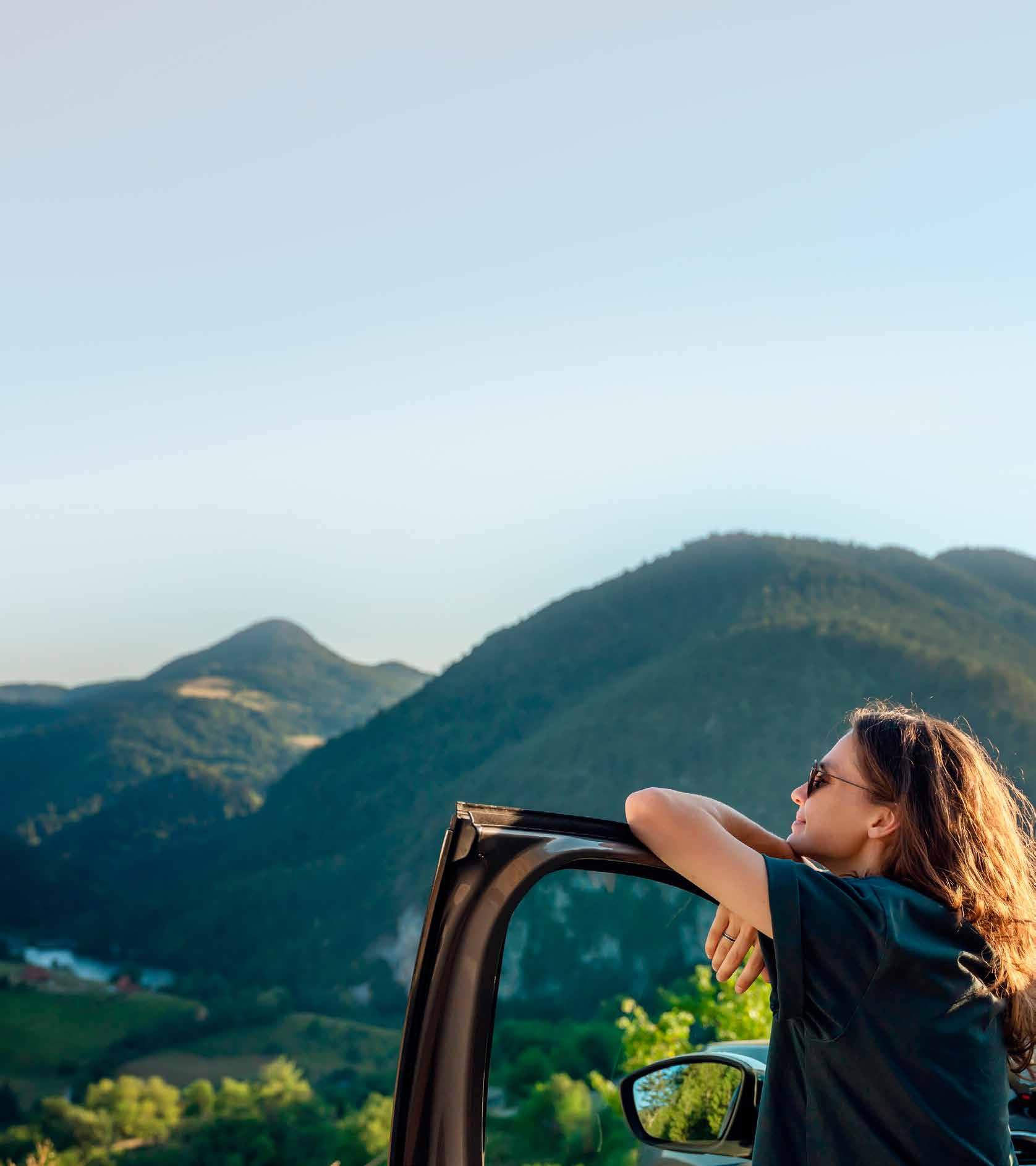


I’M ACUTELY AWARE of the challenges many New Zealanders are facing with the cost of living crisis. I hear it directly from Members when I’m visiting various parts of the country, and it makes us all the more determined to support you by providing value for money.
At our heart, we’re a club, grounded in grassroots communities across New Zealand, making a positive difference in Kiwi lives. While we are justifiably known
for our long legacy in roadside assistance, the benefits of being an AA Member extend far beyond this important service.
AA Membership gives you access to more than 40 Benefits and discounts from our Partners across health, wellbeing, travel, entertainment and more. The wider family of AA products and services gives you opportunities to get great deals on all our mobility services and insurance partnerships, too. I hope you take the time
to explore everything that’s on offer and that it eases some of the ‘pocket pain’ many of us are experiencing right now.
We ended our financial year in June and have taken great pleasure at looking back at some of our highlights as we work to meet our Members’ needs. I’m proud to say AA Membership continues to grow and that we now connect with close to 2.3 million Members and customers!
Our Roadservice Officers attended nearly 490,000 jobs throughout the fiscal year and continue to be rated the best in the country for Member and customer satisfaction. We also had more than 1.3 million people visit our Centre Networks last year. Again, the service delivery was outstanding, despite heavy driver licensing demand following the Government's decision to remove fees for resits.
Within the AA itself, we’ve made big progress in the technology space and I’m excited that we will soon be able to offer new ways to engage with us.
We’ve also continued to be a voice for our Members in the transport sphere. We’ve highlighted the need for more road maintenance for some time now, so we’re pleased to see a significant increase in Government funding for this, and more focused targets for the work that gets done over the next three years. Members will hopefully see better quality road surfaces that last longer, and potholes being repaired faster.
Another win relates to fixed speed camera signs, with the first one being in Northland recently. We have been calling for this for years; by this time next year, there should be warning signs with every permanent speed camera.
It’s also pleasing to see that legislation to bring in drug driving testing is back on the table. We believe there is a good case for roadside tests, which are widely used overseas, to deter drug-impaired driving. Hopefully the legislation manages to address concerns about people who take medication prescribed by doctors, which has been one of the stumbling blocks. Watch this space!
Before I sign off, I’d like to say a huge thank you for your loyalty as a Member. We exist to serve you and will continue to strive to deliver innovative and relevant products and services, and the best possible experience, every time.
Thank you, ngā mihi.
Nadine Tereora CHIEF EXECUTIVE
EDITORIAL TEAM
Kathryn Webster
Emily Draper
Jo Percival
DESIGN AND ART DIRECTION
Julian Pettitt, Senior Designer at SCG
HOW TO REACH US
EDITORIAL
AA Directions
He Ngākau, Level 5, 20 Viaduct Harbour Avenue, Auckland, 1010 99 Albert St, Auckland Central PO Box 5, Auckland, 1140 Ph: 09 966 8800
Email: editor@aa.co.nz
ADVERTISING
Moira Penman 021 228 5854 moira@gsjadvisory.com.au
SUBSCRIPTIONS AND MEMBERSHIP ENQUIRIES:
Ph: 0800 500 444
ISSN 1171-0179
Published in print twice a year Circulation 665,731
Readership AC Nielsen


DAWN DUTTON

She got her pilot’s licence before her driver’s licence, is mother to three girls and crochets baby blankets in her downtime which, as a fulltime photographer, is rare. Another of Dawn’s favourite pastimes is watching sport, particularly swimming and, as she also an official for Swimming NZ, there was no better person to photograph a mermaid (p.25) for our sea stories feature. Dawn also shot the image of Spirit of Adventure’s CEO Bruce Pilbrow, on p.29.
It is such a simple joy to walk along the beach, fish off the rocks, dip into the high tide on a summer afternoon. What if the sand was covered in litter, the waves were tinted with oil and the sea bed was a mess of smothering, invasive weed? What if there were no fish, no pāua? Being deeply connected to the ocean defines us as Kiwi and is something to celebrate; it should also be our resolve to protect it. That’s our role in the relationship we have with the sea.
Kathryn Webster EDITOR

TIM CUFF
Photographer Tim was in familiar surroundings shooting portraits for the article on p.10 written by his business and life partner Fiona Terry. As a volunteer marine mammal medic himself, meeting on the beach with the boss of Project Jonah has become a regular occurrence over the years, primarily at Farewell Spit. Tim and Fiona also contributed articles on Moananui (p.31) and a road trip from their home in Nelson to Kaikōura (p.50).
In the Autumn issue of AA Directions we asked Members: Would you take an alternative route to avoid motorway congestion charges?
YES: 3% NO: 97%

CLAIRE FINLAYSON
Over the last two decades, Claire has written as a freelancer on all kinds of subjects. She’s also held various roles in the arts and culture sector over the years. These days, she spends half of her week as a Communications Adviser at the University of Otago, and the other half writing from home near the ever-scratchable belly of her labradoodle. For this issue, Claire quizzed Dunedin artist Simon Kaan about his surfing obsession and related art. See p.34.
This issue’s reader poll: Do you think New Zealand’s driver licensing system needs an overhaul? Go to aadirections.co.nz to have your say. See p.40 for a story on our driver licensing system.
Regarding the article in the AA Directions’ Winter (digital) issue on New Zealand vs Australian drink driving statistics: in my view, the only effective way to deal with this is to adopt a zero tolerance stance. Harsh, meaningful consequences should be implemented for driving with any trace of alcohol or recreational drugs detected at roadside tests.
Consequences such as immediately and permanently cancelling a driver’s licence accompanied by either a significant fine, or a three month loss of liberty would be a good starting point.
Until we address the issue appropriately, people will continue to die or become seriously injured on our roads.
G Munn WAIKOUAITI
It would be interesting to know how many total years have been served in jail for the number of murders in New Zealand and compare that to how many years have been served for killings by drunk drivers.
If a person was to kill with a gun, they would be put away for a long time. If a person was to kill with a car while drunk? Forget about intent. The drunk person had all night at the pub to think about consequences.
We need tough penalties.
T Crafts
TEMUKA
Regarding the article in the AA Directions’ Winter (digital) issue on EV driving tips, I have more. Regularly take unnecessary stuff from the boot of your car and keep tyre pressure at the correct level. Also, I recently used a hot water bottle and woollen lap rug to keep warm during a chilly wait to board the Kaitaki ferry before sunrise in Wellington.
B Wilson NELSON
We have had our Tesla Model 3 for nearly three years. We have discovered that driving in heavy rain, especially when there is a lot of water on the road, reduces the range significantly. The extra friction on the tyres and against the rain drains the battery quite quickly.
A Phillipson CHRISTCHURCH
Statistically most people do a much shorter daily commute than a fully charged battery could take the vehicle. So, why keep it fully charged? Constant full charging is usually not needed for the next day’s travel, so extend your battery’s life by only charging to 70%. This is the sweet spot. Research on batteries shows that keeping the charge state lower than 80% results in greatly increased battery capacity/number of recharges, before capacity drops below 80%. Aim to drive mostly with the charge not lower than say 40% and not greater than 70%.
R Bulmer
WAIKANAE
Anticipate slowing traffic ahead so you can avoid stopping; it’s more efficient. An EV uses more power to start from zero and there are benefits to slowing gradually rather than stopping completely to conserve power. Smooth driving is key; it is more comfortable for passengers and encourages closer attention to what’s happening up ahead.
J Clark TAURANGA
Regarding the interview with Simeon Brown (AA Directions, Autumn 2024): to describe light rail as a ‘distraction’ is dismissive, derogatory and totally anachronistic.
Readers who have visited major cities in the developed world will have used clean, mass rapid transport systems that move huge amounts of people effortlessly from airports and around the city, leaving roads free for those who really need them.
M Dickens WELLINGTON
36 AA Centres around New Zealand
More than
18,000
hi-vis vests supplied by AA to school traffic safety patrollers
40+ exclusive AA Member Benefits
490,000
AA Roadservice jobs last year*
54,032 batteries recycled by
Directions' Spring and Autumn issues are printed and also delivered in digital format. The Winter and Summer issues are digital only. Follow AA Directions on Facebook or Instagram @aadirections
General Manager of Project Jonah, Daren Grover, is a passionate campaigner for marine mammals. The Nelson resident talks to Fiona Terry about the organisation that’s been saving whales and dolphins for the last 50 years.
What is Project Jonah?
We’re a not-for-profit organisation focusing on marine mammal welfare that’s been saving whales since 1974. Our work includes direct response to whale and dolphin strandings around the country, as well as raising awareness of the potential negative impacts of our actions as a society on their environment. Another important aspect of our work is education in schools, and training people to become Marine Mammal Medics to work with animals during a stranding.
How often do strandings occur in New Zealand?
On average, we expect approximately 300 events each year, which includes mass and single strandings, as well as dead whales. Strandings are complicated events. They can be caused by illness, old age, weather and tides, being struck by a boat, ingesting ocean-borne rubbish, chasing prey and impacts of climate change.
What’s the biggest stranding you’ve assisted with?
In February 2017, over 600 long-finned pilot whales stranded on Farewell Spit in Golden Bay. That was a three-day event.
We asked all our Marine Mammal Medics based in Wellington and the top of the South Island to attend, and we also sent out calls to the media. I was there at first light and there were close to 300 whales still alive at that stage. We had over a thousand people turn up each day to help – it was just incredible.
On the third day we managed to refloat those surviving whales. We had a few hundred people, waist-deep in the ocean, forming a human chain barrier to prevent them swimming back up onto the beach. Another pod of pilot whales came into the bay, so there were around 500 whales. They swam along the human chain, almost within touching distance. It was an incredible feeling.
Finally watching them swim away was emotional, but seeing those that hadn’t survived on the shore was devastating.
How many people are involved in Project Jonah?
There are two of us working full-time – myself and Communications Manager Louisa Hawkes – and 15 experienced volunteer regional leaders, strategically based around the country to coordinate our medics at strandings.
We’ve also got over 5,500 volunteer Marine Mammal Medics who’ve completed our specialised training course and elected to be on call to respond to strandings in their region.
What is it important to do if a dolphin or whale strands?
What’s needed isn’t always common sense, which is why we do a lot of educationbased work.
Anyone who finds a whale or dolphin on the beach should phone either us or DOC for help, as we will alert each other. The response depends on the species. A single large sperm whale on the beach calls for a very different response to a mass stranding.


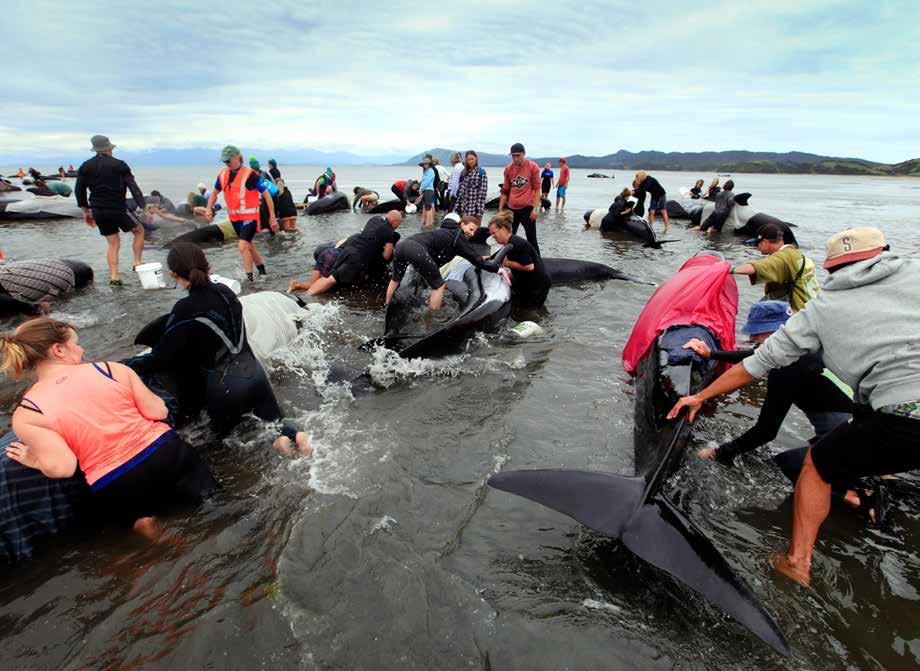
Experts Panel at the International Whaling Commission. We reach out if there’s a particular event we haven’t experienced before, and vice versa. We’ve been able to help others with advice, too.
over 12,000 children, and at the start of next year we’re launching a very exciting education resource – a life-size 15m-long inflatable humpback whale that has a classroom in its belly, with the anatomy of the whale inside.
Project Jonah is 50 years old. How did it start?
Project Jonah initially started by campaigning against the re-establishment of commercial whaling in New Zealand in the early 1970s. We were one of those early voices for protection for marine mammals. Then Frank Robson, who was a welfare specialist, worked to build up knowledge of what to do in the event of strandings. At the time, we were trailblazing. Since then we’ve shared that knowledge with other groups around the world.
Almost 40 years ago, some of our volunteers pioneered inflatable rescue pontoons which give extra buoyancy when refloating mammals. They’re amazing pieces of equipment that have saved hundreds of lives and are now being used by many organisations around the world.
The key is to reduce the animal's stress and keep them cool by pouring water over their bodies. If you haven’t got a bucket, use a shoe to scoop the water, or soak a jumper, towel or whatever’s handy to keep the skin wet and shiny but make sure to avoid the blow hole as that’s the only way they breathe.
As the tide comes in, we hold them in place and stop them rolling onto their sides before they can swim. If it’s a mass stranding, we want to refloat them all at the same time.
What does your work involve?
I’ve been involved in 200 incidents in my 12 years with Project Jonah. Of those, I’ve attended around 40. A lot of the work we do is responding in the moment to give people guidance on what they should and shouldn’t do.
Whether we’re working remotely or mobilising, we’re reaching out to our medics in the region via a web-to text system that can reach several hundred people. We send specific instructions to those available so they can assess the situation and engage with members of the public.
We also liaise with a global network of around 20 organisations, which includes the International Fund for Animal Welfare, and the global Stranding
What’s it like attending a stranding?
It’s highly emotional: whales have distress cries that signal for help, which could lead to further strandings as other animals respond.
When you spend time with a whale you get that you’re connecting with another soul. Some people find it quite spiritual and some start to quickly bond with the animal. If that happens and the whale dies, we have grief-stricken people who’ve worked hard to try and save it. Part of our role at Project Jonah is to look after the people so they can look after whales and dolphins. There are a few things we can do to help protect people, like rotating those helping to manage the time they spend with individual animals.
What does your education programme involve?
We run 15-20 Marine Mammal Medic trainings around the country each year. We also have contractor and volunteer education presenters who go to kindergartens, schools and community groups with resources, including inflatable life-sized dolphins. We teach what to do if they find a stranded whale or dolphin on the beach and talk about the human impacts on the marine environment. Last year we presented to
What do you see as the goals for the future?
My personal overarching goal is that every Kiwi knows what to do if they find a stranded whale or dolphin.
I’ve just come back from a knowledge sharing trip to the International Fund for Animal Welfare (IFAW) centre in Cape Cod. They do what we’d like to do if we had an almost unlimited budget – they’ve got technology to help triage stranded mammals and have the ability to transport several dolphins in an ambulance at a time. While the ambulance is driving to a beach to release them, medics can do CT scans and blood work.
Where do you get your funding from?
We are a charity, so we exist thanks to donations from the public, businesses and grants from family trusts and organisations like IFAW. While we achieve so much, we always invite offers of help to progress our work further.
A lot of our time is spent fundraising and educating. We are a small and underfunded organisation but ultimately it is work with incredible value and we do get the chance to make a life-saving difference.
www.projectjonah.org.nz
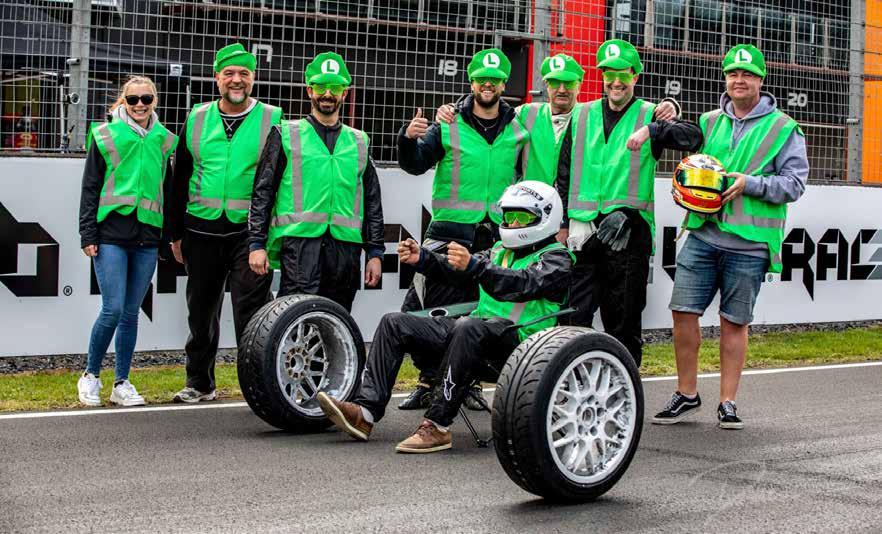
THIS NOVEMBER, Highlands Motorsport Park in Cromwell will be home to racing with a zesty twist. Nazcar LEMONS takes over the track on November 2, with the debut showcase of grassroots racing. Costumed teams and shonky cars will compete in a 9-to-5 endurance event that promises to be as colourful as it is fun.
“Cromwell is hailed as the ‘fruit capital’ of New Zealand, so it’s fitting that Nazcar LEMONS should become

part of the local diet,” event organiser Dr Jacob Simonsen says.
At Nazcar LEMONS, the emphasis will be on fun, safe and memorable motorsport, with free entry for spectators. Expect seasoned drivers competing against newbies, existing race cars, and some cobbled together home-builds taking the track for a day of guaranteed hilarity, antics and silly penalties.
For more information, see nazcar.nz

THE BAY OF PLENTY Garden and Art Festival is back, offering a vibrant fusion of lush gardens and captivating art. Held over four days – November 14 to 17 – this much-anticipated event showcases the region’s finest private gardens and local artistic talent.
As you explore over 60 gardens located across Tauranga and the Western Bay of Plenty, you’ll also discover sculptures, paintings, and installations from local artists. And at the festival’s hub,
Bloom in the Bay, you’ll be treated to live music, food stalls, family-friendly entertainment and even more art and garden displays. Whether you’re a garden enthusiast, art lover, or simply looking to support the local community, the Bay of Plenty Garden and Art Festival promises a memorable experience.
Tickets are available online at gardenandartfestival.co.nz or pop into Palmers Garden Centre Bethlehem to grab a festival pass.


Ultralight | WORLD ’ S LIGHTEST CARBON FIBRE WALKER AWARD-WINNING SCANDINAVIAN DESIGN. HEIGHT-ADJUSTABLE ERGONOMIC HANDLES. STRONG. FOLDABLE INBUILT SEAT. MORE COLOURS, BAGS & OTHER ACCESSORIES AVAILABLE






Motion | 2-IN-1 WALKER & WHEELCHAIR. AWARD-WINNING DUTCH ENGINEERING. TRANSFORMS IN SECONDS FOLDABLE. ROBUST ALUMINIUM FRAME. ERGONOMIC HEIGHT-ADJUSTABLE HANDLES. THE ONLY 2-IN-1 THAT MEETS AU/NZ STANDARDS FOR BOTH WALKER & WHEELCHAIR.
•
•
•
To celebrate our Spring issue, we have some great reader prizes up for grabs!
Escape to the Wairarapa region for a wonderful weekend away. Be in to win a getaway for two people including one night’s accommodation at the Martinborough Hotel, a Star Safari dark sky tour, a luxurious lunch at the brand new Urlar winery and a Patuna Chasm experience. See p.55 for more.


Sound engineer Tex Houston knows a thing or two about optimal audio, which is why he has made a business of hand building unique hi-fi speakers. Be in to win a pair of gorgeous Tex Tone Classic Mini speakers, valued at $2,900. See p.75 for more.
Darwin to Broome 11 days, departs August 2025
Package includes:
• All kiwi group
• Return flights
• Comfortable hotels
• Extensive sightseeing
• Many meals

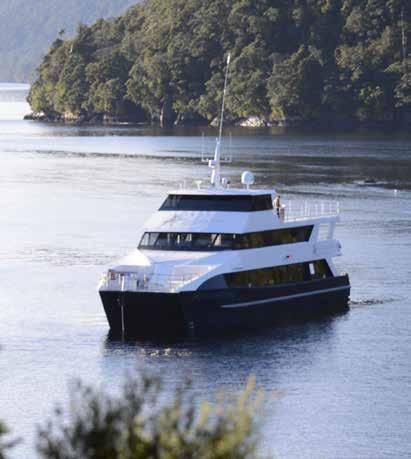
Follow in the footsteps of Captain Cook, but in luxury on a Fiordland Discovery Cruise. We have a six-night Fiordland Southern Fiords cruise for two people up for grabs. Travelling aboard the beautiful Fiordland Jewel, the cruise is available in May or June 2025. See p.57 for more.
To be in to win any of these prizes visit our website aadirections.co.nz and enter the draw. Or, you can send your name and contact details, plus the name of the prize you want to win, to: AA Directions, PO Box 5 Auckland, 1010. All entries must be received before November 30, 2024.
Chicago to Los Angeles 16 days, departs September 2025
Package includes:
• Vehicle rental
• Ford Mustang upgrade available
• Hotel accommodation
• Route 66 attractions
• Comprehensive tour notes
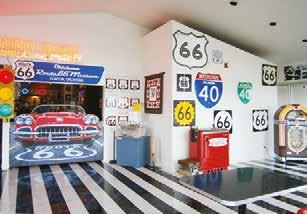
42 days, departs May 2026
Package includes:
• Motorhome tour
• Motorhome rental and insurance included
• Inside Passage 7 night Cruise
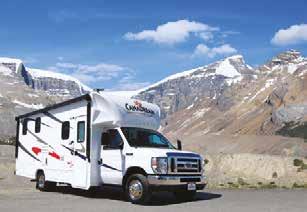

MAGIC, SPARKLE AND DELIGHT return to the stage this Christmas season with the return of Royal New Zealand Ballet’s A Midsummer Night’s Dream.
RNZB’s production of the Shakespeare classic became an overnight sensation when it debuted in 2015, with full houses and to critical acclaim. Its stunning set and costume designs bought Shakespeare’s timeless characters and enchanted wood to life in a visually splendid performance, enthralling audiences with glorious choreography, humour and Mendelssohn’s iconic music. With its return, A Midsummer Night’s Dream promises to captivate audiences once
more, with performances in Wellington, Christchurch, Dunedin, Palmerston North, Napier, Rotorua, Auckland and Takapuna between October 24 and December 24, 2024. Performances in Wellington, Christchurch and Auckland will feature Orchestra Wellington, the Christchurch Symphony Orchestra, and the Auckland Philharmonia Orchestra. AA Members enjoy a 15% discount on adult and child tickets to RNZB performances, when booked online. See aa.co.nz/ membership for details.



THAMES, on the Coromandel Peninsula, gets extra interesting for a few days in November with the annual Steampunk Festival. For four days it’s all dancing, prancing, gears and gadgetry, with a calendar busy with colourful celebrations. With a big emphasis on costumes, Steampunk the Thames kicks off on November 7 with a meet and greet soirée and continues throughout the weekend with high teas, a Victorian ball, fashion show, parade and gigs – some ticketed, some free. Sunday in the Park, a family event on the last day of the festival, features market stalls, food vendors, music, teapot racing – involving remote-controlled contraptions – and crowd favourite, Punk My Pet. See steampunkthethames.co.nz for more information.


DRIVERS STUCK BEHIND slower vehicles can get frustrated and then attempt risky overtaking manoeuvres. Passing lanes and slow vehicle bays offer the safest opportunity for drivers to overtake slower vehicles.
Regularly check your mirrors and, if you have vehicles behind you, signal left and move into the left lane as soon as possible.
Watch your speedometer and don’t let your speed creep up when you get to a passing lane. You may even need to slow down to allow vehicles behind you to pass.
The Road Code advises that before passing, make sure you will be able to see at least 100m of clear road ahead once you have finished passing.
Check behind (both your mirrors and blind spots) to make sure there are no vehicles overtaking you.
Signal for three seconds before overtaking, and then check that you can see the vehicle in your rear view mirror and signal for another three seconds before pulling in front of the vehicle you’ve passed.
At the end of a passing lane, the best way to merge is like a zip, where drivers let one vehicle from the other lane go first, and then go themselves. Vehicles in the outer lane don’t have priority. Vehicles in the left lane should signal right, and vehicles in the right lane should signal left.
Slow vehicle bays are like passing lanes, but much shorter. They are
often located on hilly and winding roads where there isn’t room for a long passing lane.
If you have traffic behind you, you should keep left and pull into the slow vehicle bay to allow others to pass.
Slow vehicle bays aren’t just for trucks, tractors or vehicles that are towing. They are for anyone travelling slower than other traffic. You should regularly check your mirrors and, if there are several vehicles behind you, pull into the slow vehicle bay and slow down, (if it is safe to do so), to give the other traffic a chance to pass safely.
Some bays are called stopping bays for that purpose, but the same rules apply: if there is traffic behind you, pull in, stop and wait until the traffic has passed before re-entering the lane.


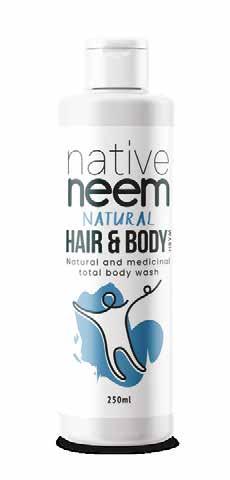

A complete range of natural care products for people, pets and plants made with the power of Neem. nativeneem.com






DISCOVER THE MAGIC of garden design at the Auckland Garden Designfest, a biennial celebration that brings together some of the city’s most inspiring private gardens. This year’s event, held on November 23 and 24, offers a chance to explore up to 16 beautifully crafted gardens across Auckland.
Wander through a variety of private spaces normally inaccessible to the public, gain insight into the creative process, and meet some of New Zealand’s landscape design elite. Alongside garden entry there is also an option of guided bus tours led by expert landscape architects that include a picnic lunch and refreshments.
Whether you’re a seasoned gardener or simply appreciate stunning outdoor spaces, the Garden Designfest offers plenty of inspiration. Tickets are available online at aucklandgardendesignfest.co.nz, at any Dove Hospice shop across Auckland, or from the first garden you visit on the festival weekend. All proceeds go to supporting local charities.

SOUTHLAND IS THE LATEST New Zealand region to welcome soft plastic collection bins. Both Invercargill and Gore have joined the Soft Plastics Recycling Scheme, providing bins at The Warehouse and Woolworths stores in both towns. Recycle South collects soft
plastic from the bins and prepares it for transport to Future Post’s facility in Blenheim for recycling into fence posts and raised garden beds.
The scheme has recently launched in Marlborough, Nelson and Tasman, wider Otago and Whanganui and now covers
most of New Zealand, from the Far North to Southland, with 300+ drop off locations. More than 87% of New Zealanders now have access to a soft plastic recycling bin within 20km of home or work.
AA Directions belongs to the Soft Plastics Recycling Scheme to provide a solution for the plastic film that the magazine is delivered to Members in. Adding the plastic wrap to the right recycling bin ensures it is directed to a productive end, rather than going to landfill.
See recycling.kiwi.nz/store-locator to find the closest collection point.
THE HAWKE’S BAY region is renowned for being a stellar producer of fantastic food and fine wine. This November you can get a real taste of the region’s
delights at Harvest Hawke’s Bay Wine & Food Festival.
Celebrating its second year in 2024, the festival takes place on November



23 in a stunning olive grove setting in the Tukituki Valley at the foot of Te Mata Peak. A picnic-style festival, tickets are limited to just 2,200 to ensure festivalgoers can enjoy a relaxed and intimate day out.
This year, a mix of well-known and boutique products will be the star ingredients in specially prepared fare, from Hōhepa cheese and Arataki honey to locally grown produce.
Many local eateries will create signature dishes for the event, including Black Barn Bistro, Mister Ds, Deliciosa and Cellar 495. And participating wineries will showcase the best of the region’s terroir with tipples available from Collaboration Wines, Decibel Wines, Smith & Sheth, Te Awanga Estate, Trinity Hill and many more.
Limited tickets are available from Eventfinda. For more information, see harvesthawkesbay.com




TAURANGA IS NOW home to New Zealand’s largest EV charging hub. ChargeNet NZ, the nationwide EV charging network, officially opened the hub in early August, amid growing demand for electric charging infrastructure across the country.
The new Tauranga Crossing site can charge up to 10 vehicles at once – more than any other charging hub in the country. These chargers can add 300km of range in 20 minutes, which is enough to power most EVs from Tauranga to Auckland, or to Hamilton and back. In addition to standard charging options, the new site also includes two ‘pull-through’ charging bays for small electric trucks and EVs towing trailers and campervans.
The Bay of Plenty site is strategically located in New Zealand’s Golden Triangle – the area between Tauranga, Hamilton and Auckland, home to over 50% of the country’s population. With EVs continuing to be an attractive option for New Zealanders, and the busy site seeing approximately 26,000 vehicles per day on average, enhancing charging accessibility in the area has been a priority.
Jointly funded by ChargeNet NZ and EECA, with co-funding from EECA’s Low Emission Transport Fund (LETF), the $1.8 million hub is an important step towards a net zero emissions economy and helping current and future EV drivers feel confident on our roads.
For more information see charge.net.nz

your next car through our AA Preferred Dealer Network and you’ll know they’ve met our standards of quality to give you confidence in your car purchase.


e live on an island, so it’s not surprising we’re deeply connected with our coastline. Our ancestors arrived by sea, landing where the ocean meets the shore, and we have relied on the sea to provide ever since. Casting a fishing line out, collecting shellfish, diving
for pāua, kina and crayfish is a part of life here. And we enjoy the sea; we have fun in it, splashing about in its shallows, surfing its swells, sailing and kayaking and rowing dinghies across its surface.
There’s a spiritual connection, too. We’re in awe of it, we respect it, and we appreciate what the ocean gives. Many

New Zealanders take an active role in protecting the sea in return – advocating for marine reserves, preserving its resources, caring for what happens to sea life in all its forms. It’s a precious relationship, one to acknowledge and celebrate – which we do here, in seven stories of the sea.
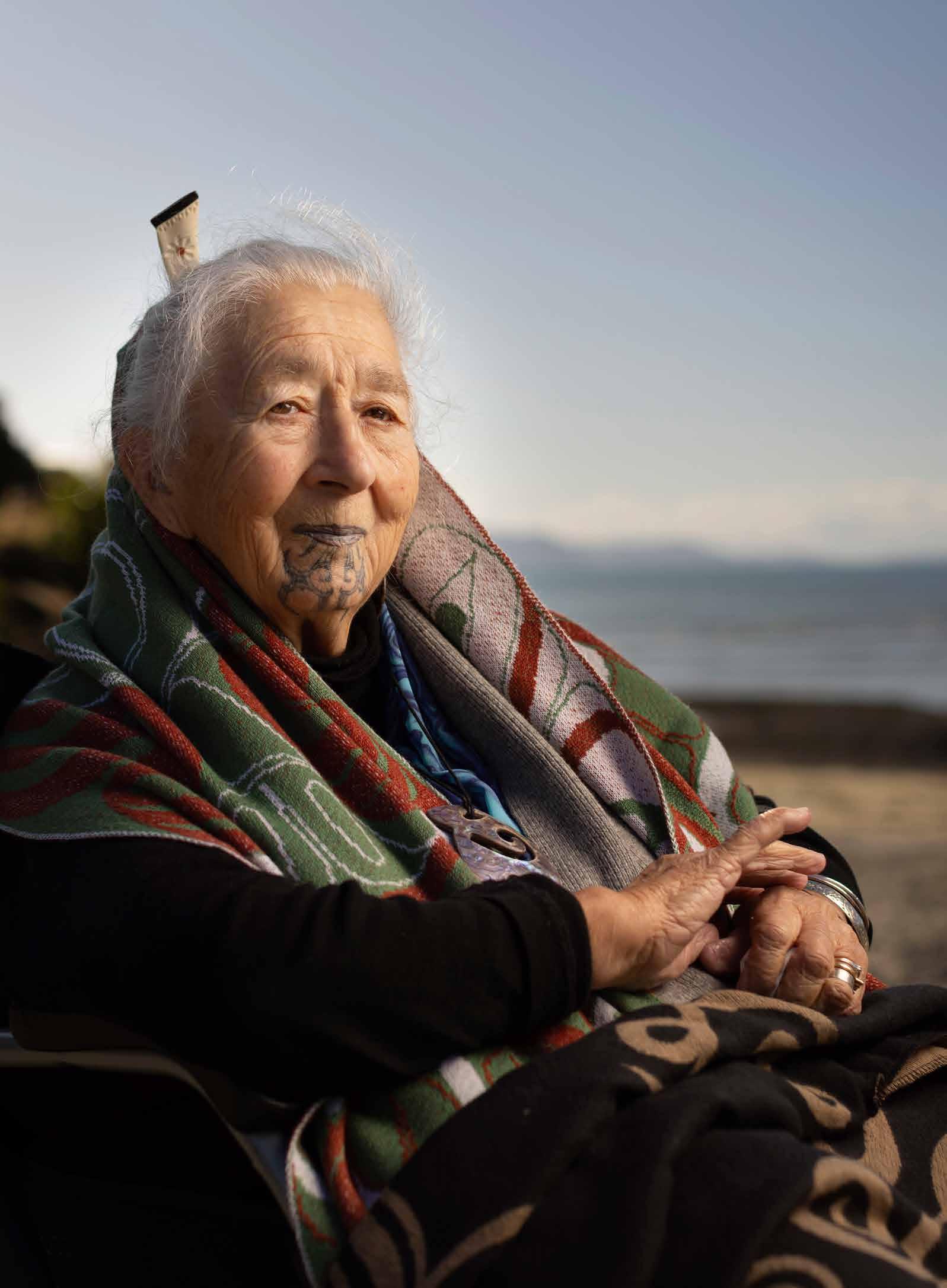
Draper visits an ocean warrior in Māhia Peninsula, Hawke’s Bay.
OVER MĀHIA’S GENTLE HILLS, around the lagoon and past the local school, I find her: a woman carved by the sea.
Pauline Tangiora is frail. Seated in her living room, she sucks air in urgently before speaking, the words tumbling out in a rasp.
And yet, surrounded by the photos and mementos of an incredible life – shaking hands with the Dalai Lama, riding a motorbike from Northland to Bluff, speaking at the United Nations – it is not Pauline’s frailty you notice, but her strength. Her eyes, deep brown with flecks of amber, are steely and determined, flickering with fights still to be fought.
I’m here to talk to Pauline about the sea. What does it mean to her? It must seem a foolish question: there’s a hint of a wry smile.
“When the world was in darkness, Rangi and Papa came together and brought light to the world. Tangaroa (God of the Sea) was the centre of those two,” she pauses.
“My relationship with Mother Earth, the whenua, Tangaroa, Rangi and Papa – those things are part of me. Tangaroa is me and I am Tangaroa.”
Although born in Ahuriri, near Heretaunga (Hastings), Pauline’s home has always been Māhia, and in Māhia, it has always been the sea. Home of their Rongomaiwahine iwi, her family would travel to Māhia every weekend for meetings, where she and the other children would run to the rocks and spend hours hunting for crayfish and pipi.
Before the last whale was caught in 1966, whaling was a major industry in Māhia, something Pauline looks back on with sadness. “My father could never understand why they wanted to kill the whales. The stories told in our family were that the whales were part of the living soul of the people.”
Pauline has led a long career in advocacy. It began in Taumarunui,
rallying with local women against the use of Monsanto herbicides, and then in the 1960s against the Vietnam War.
However, no cause has been closer to her heart than that of protecting our water and kaimoana, culminating in her five years as Chairperson of the World Forum of Fisher Peoples.
“We started the (World Forum) because the ocean people couldn’t find their fish. Most indigenous people live on coasts, rivers or lakes, particularly in New Zealand. For many, it’s where they get their food. If we destroy those, we’re going to have no kaimoana. Not just for the local people, but for the world.”
It’s clear that Pauline’s fight for water is also a fight for a way of life for Māori and all indigenous people – and this fight starts with what we teach our children.

the Māori Women’s Welfare League. In 2005, she was nominated for the Nobel Peace Prize as part of the 1,000 Women for Peace project, and she has appeared on a number of UN billboards around the world, alongside being a māmā to eight children and grandmother to an untold number of mokopuna.
Despite her many accolades, humility and togetherness come first.
“To serve the people, you need to be humble. What you believe in, what you’ve learned, that you are true to yourself, that is important. It’s not a case of where you go, it’s that you must take the people with you. The awards that you get are the rewards for the people.”
At the heart of Pauline’s tireless championing of our oceans and waterways is a strong belief system: that
Most indigenous people live on coasts, rivers or lakes, particularly in New Zealand. For many, it’s where they get their food. If we destroy those, we’re going to have no kaimoana. Not just for the local people, but for the world.
“As grandmothers and greatgrandmothers, we’re trying to bring up our mokopuna to realise that you have to be responsible. We have to teach our children to take just enough for your table – not the freezer. Each person living by the sea is responsible to keep it clean and viable. Nobody owns it, but indigenous people have that responsibility, as they have been there since mai rā anō (long ago).”
In addition to the World Forum of Fisher Peoples, Pauline also served as a representative for the World Council for Indigenous Peoples, a member of the Earth Council and an Earth Charter commissioner, a Patron of the Peace Foundation, and a lifetime member of
our natural world cannot be sectioned off into disparate areas, but rather should be seen and preserved as one global, interconnected system.
“The ocean moves north, south, west, east. The moves of the tide, the whitebait coming out to spawn, the eels in schools, the riverbanks; every little understanding of the water, is all connected.”
And there’s nowhere Pauline feels this connectedness more than Māhia.
“Māhia Peninsula is spiritual. It’s the wairua of the old people still in that land. As you grow older, you’ll feel it. All the coastal lands have that old wairua. Because the seas are ever cleansing the land, cleansing the damage that is done.”
ONE OF THE HARDEST things about being a mermaid is making it look easy. As head mermaid at FreeDive Aotearoa, this comes up a lot for Sacha Williamson, who must look at ease despite the cold. Even when her eyes sting in the salty water and her tail is threatening to drag her down, she must float fish-like, elegant and carefree.
Reality versus fantasy is hilarious, Sacha laughs. “It’s the most brutal sport I’ve ever done and I have been a commercial diver, welding underwater. This is, for real, the hardest thing; I have to look like I'm not pained, in cold water, with no wetsuit and no mask. Then they want me to get back under water for another photograph and to look nice...”
But she manages. With a flick of her iridescent tail and a swoosh of her arms, she weaves and curls around light shafts piercing the sea’s surface, making it look easy.
Her Tutukākā-based free dive school includes taking clients – with and without mermaid tails – out to the famously beautiful Poor Knights Islands. She and her team also offer ocean resilience courses which focus on deepening the understanding of, and connection with, the sea. These education programmes have extended into school and tertiary environments; she’s passionate about the regenerative practices and sustainability messaging that goes hand-in-hand with learning about survival at sea. She’s passionate about everything ocean; she’s positively salty.
Sacha was a commercial diver for many years, fixing ship hulls and marine
infrastructure, working in aid situations in the Pacific, doing “very grunty, masculine work”. Wanting to draw attention to the health needs of the ocean, she switched, ten years ago, to scuba instructing and then to freediving, first as a practitioner and then as an advanced-level instructor.
While not every freediver is tempted to don a mermaid tail, the fact that Sacha is mother to three girls made that watery leap inevitable. “I tried to have a neutral home!” she laughs. “Then I realised my house was full of pink and fluff and sequins, and when they started swimming, they wanted mermaid tails, and I said yeah, of course you can!”
But it’s not only young girls and their mothers who like to mermaid. It’s quite

a graceful, easy freedom of movement. Swimming with a tail is also extremely efficient, as demonstrated by fish! The deepest discipline of freediving involves using a mono-fin. “It’s incredibly powerful. You can feel the torque of a mono-fin, when you’ve got the proper one fitted, it’s amazing.”
It takes a lot of training to get to the point of mono-fin freediving in a mermaid tail between offshore islands, though. Many swimmers will be satisfied with an estuary experience, happy to splash droplets from the scales of a glistening tail or to pose on a pool edge for a photo. Others go on to advanced training, keen to hold their breath underwater for long enough to
It feels like coming home for me. It’s just incredible, the feeling of being in water. I love everything to do with being in water. It wants for nothing. You’re just in that moment, with ease.
the worldwide phenomenon; many of her clients are overseas tourists and around 70% are adult. They are predominantly female, but not all.
“One of my favourite things is to see dads just throw caution out, get in the pool with their kid and have fun. I love to see their big grins.”
As well as the fun factor, it’s liberating – and has a potent element of enchantment to it. “Something magic happens when you go into the water.”
Every body looks good in a tail, she says, and with the loss of gravity comes
feel like they belong there, to swish through the deep among the fish and kelp. Some want to stay. People have been known to quit high-powered corporate lives to become mermaid instructors.
For Sacha, who has made a life of being in the sea, fleeing an office job for a life as a mermaid makes complete sense.
“It feels like coming home for me. It’s just incredible, the feeling of being in water. I love everything to do with being in water. It wants for nothing. You’re just in that moment, with ease.”

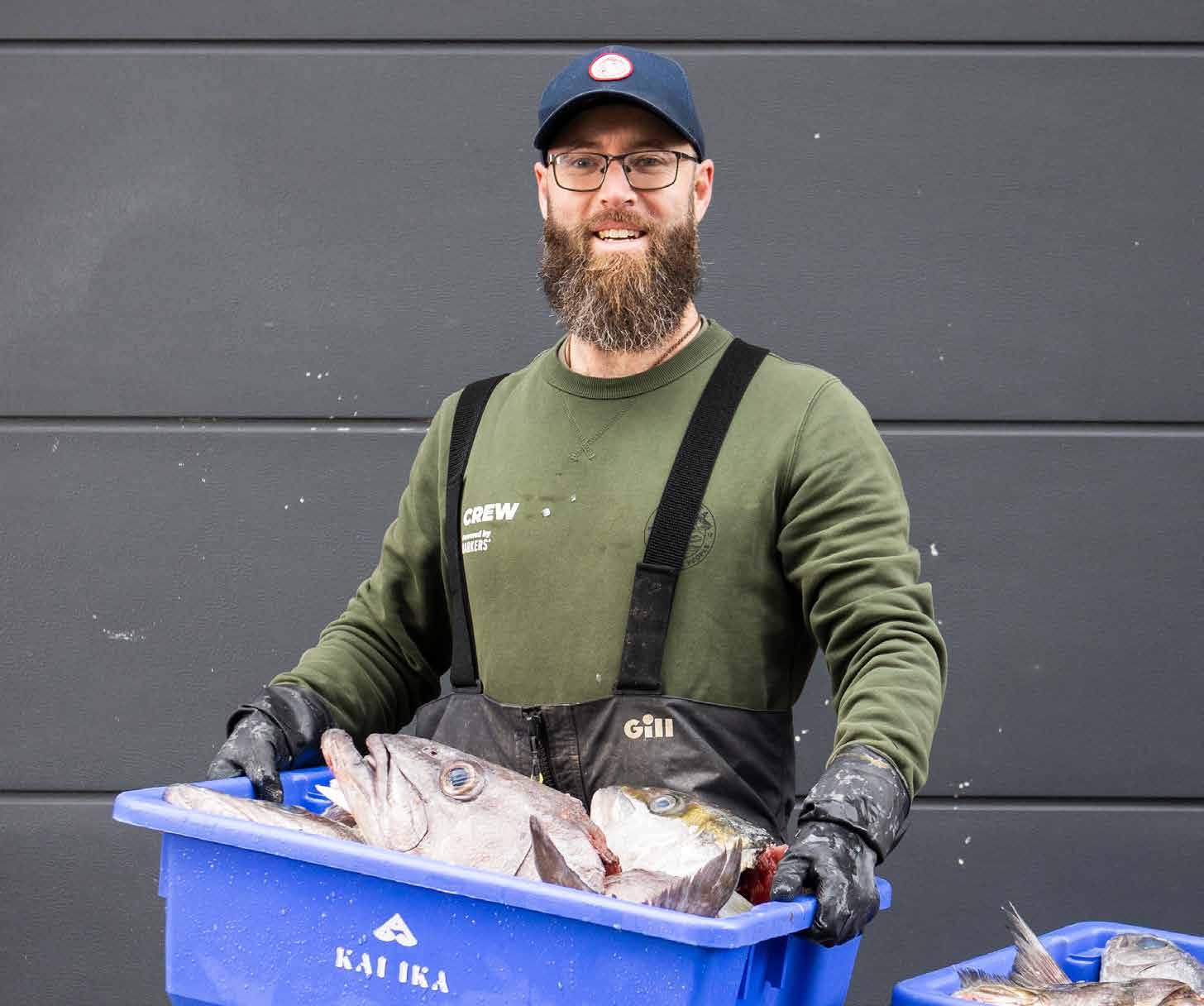

The Kai Ika Project in Wellington helps avoid fish waste, Nicola Edmonds reports.
CHRIS JUPP spends his Thursdays elbow deep in fresh fish parts that might otherwise be bound for the bin. He fills bags, buckets and boxes with many kilos of fish heads and frames to distribute to members of the Wellington community, who treasure this bounty.
He is operating a satellite of LegaSea’s The Kai Ika Project, initially established in Auckland in 2016 to address the interconnecting issues of food insecurity and marine sustainability in New Zealand.
Chris is project leader, but he’d rather be known as “just the delivery man.” He liaises with Wesley Community Action and Kōkiri Marae, which spread the word amongst the community. “We let them know that we’re going to be in a certain place, at a certain time, every Thursday, and people come with their buckets and their chilly bins, collect their fish and take it home.
“We make a real effort to get this kai onto family dinner tables that are most impacted by the current cost-of-living
crisis. Many of the families who collect fish parts tell us that this has become their only source of meat-based protein.”
Joy is integral to The Kai Ika Project, he says. “Not only is there food on dinner tables, there’s joy in this celebration around those dinner tables. Fresh fish has become really expensive and if you don’t have the means to be able to go out and catch fish for yourself, it’s pretty difficult. So, people are loving it.”
Chris believes the current approach to fishing is short sighted. “In many ways, The Kai Ika project shouldn’t exist. It’s the ambulance at the bottom of the cliff; if we were using the whole of the fish, we could have the same amount of food on tables but take considerably less fish from our oceans.”
The mad-keen fisherman has been dropping a line in Wellington’s waters since childhood. He confesses he used to throw all the heads and frames in the bin. “Now, I enjoy getting some nice snapper heads on the barbecue and smoking them up, but I also make sure I’m using or gifting every part of the fish I catch.”
During summer, The Kai Ika project is supplied by both recreational and commercial fishers. “Where we can, we provide a filleting service at fishing club competitions, and that’s also an opportunity for us to generate funds to support the project. In Wellington, our commercial suppliers provide the bulk of our supply for the rest of the year.
“I’m constantly getting messages from recreational fishers, saying, ‘Hey, can you guys take these bits and share them on?’ Funnily enough though, it costs money to give fish away for free.”
To avoid becoming a bottleneck in the chain of supply and demand, Kai Ika is about to launch a Free Fish Heads app, aimed at providing a peer-to-peer sharing platform to connect fisher people with community members.

Not only is there food on dinner tables, there’s joy in this celebration around those dinner tables. Fresh fish has become really expensive and if you don’t have the means to be able to go out and catch fish for yourself, it’s pretty difficult.
“Seeing community stakeholders, businesses, councils and random, passionate fisher folk coming together to look after and share this resource is incredible. The challenge is that there’s always more demand to meet. We’re constantly in catch-up mode, but what keeps us focused and moving forward is knowing that there’s plenty more fish heads out there and plenty more dinner tables where they would be gratefully received.”
Chris hopes to eventually see long term change, to the extent that fish heads and frames are as valued by commercial and recreational fishers as fillets are. “And that any family in New Zealand who wants to enjoy some fish can access that fish.”



Can ten days at sea change a life? Emily Draper investigates.
THE SPIRIT OF ADVENTURE: Te Waka Hiringa Tangata, operates over 35 youth development voyages a year. Since its maiden voyage in 1974, over 85,000 young people have taken a place on the iconic sailing vessel, developing skills, making lifelong friends, and discovering their true potential at sea.
Now, fresh from celebrating its 50th anniversary, CEO Bruce Pilbrow is keen to convey that the spirit of Spirit of Adventure is alive and well.
“We see a massive change in young people. I’ve worked with youth on and off for about 25 years, and I’ve never seen anything transform a young person like this.”
It’s clear Bruce is passionate: his eyes light up when he talks. “This next generation is amazing. They are awesome at holding us to account. They’re our future prime ministers, nurses, doctors, teachers.”
The Spirit of Adventure offers a range of programmes, but the cornerstone is the 10-day voyage for students in the last two years of secondary school. Stripped of their digital devices and tasked with the challenge of sailing the three-masted vessel out of the Hauraki Gulf and beyond, rangatahi soon find themselves in a whole new world, with a whole new perspective.
“Initially, it’s a bit of a shock for them to give their device over. Often, they’ve been living in a world that’s a couple of inches square, and that becomes their existence, their identity.
“We create space where they can see themselves for who they are, their goodness, without all the other noise. It starts to shift things, and they start to fall in love with themselves again. They start to say: I’m capable, I’m confident, I have ability.”
This transformation follows such a regular pattern that crew joke about its predictability.
“When they first walk on, they’re all, hands in pockets, trying not to look
anyone in the eye. Usually by about day six, they get a bit feral. All the safety nets they put around themselves on social media are gone. They’re tired, and they start to have a few clashes.
“But, by the end of day six – we can almost set our watches to it – there's a click. Suddenly it’s a community, it’s ‘you’re struggling, I’ll help you, I’m struggling, you help me’.
“By day 10, they can’t let go of each other. It’s all tears, waiata, hugging, and then they stay friends for life.”
Alongside personal development, helping participants develop a keen sense of care for the ocean is central to the Spirit’s mission.
This ethos of environmental stewardship has motivated the Spirit of Adventure to undertake a number of conservation and sustainability

feeds us. It teaches us. It’s spiritual. It provides sustenance for life. You’ve got to look after it, eh?”
In addition to the 10-day programme, the Spirit also offers five-day voyages for younger students, a parent-child expedition, and an annual ‘inspiration voyage’ specifically for people aged 16 to 30 living with a disability.
Recalling a previous inspiration voyage, Bruce describes someone with low vision scaling the highest point on the ship.
“I watched a guy stow away a sail 38m up. Then he climbed all the way down, got to the bottom, walked over and grabbed his cane. Yeah, that’s why we call it inspiration.”
For students who wish to join a Spirit of Adventure voyage, there are numerous scholarships available.
We create space where they can see themselves for who they are, their goodness, without all the other noise. It starts to shift things, and they start to fall in love with themselves again. They start to say: ‘I’m capable, I’m confident, I have ability.’
initiatives: upgrading its sewage treatment plant, working with Moana Project to take ocean temperature recordings and regularly scanning the seabed for global initiative Seabed 2030.
It’s not just large-scale initiatives, however; these values also extend to the everyday movements of each voyage.
“We turn the whole ship around if we see a piece of plastic in the ocean. To get 14 sails up is a major job, and when you’re cranking along at 10 knots, turning it around is a lot of work, but to do so sends such a powerful message to young people.
“We live on this beautiful island in the middle of nowhere. The environment
“We never want money to be a barrier. If a young person wants to get on and can’t afford it – we’ll get them on. We normally average about 35% in scholarships – but this year, we’ve raised enough money to give every kid a scholarship.”
Whether it’s the thrill of hoisting sails, the camaraderie of working together, or the quiet moments of reflection under a starry sky, the Spirit of Adventure offers an experience like no other. With newfound resilience, courage and connections, young people return to shore not only better sailors, but better equipped to chart their own course through life.




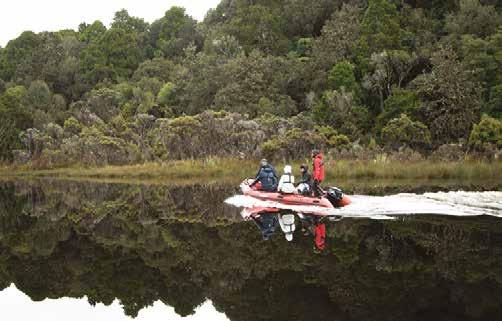
Heritage Expeditions have been sharing the wilds of New Zealand with like-minded guests for more than 40 years and invite you on the voyage of a lifetime. Explore Fiordland’s world famous Acheron Passage and Breaksea, Dusky and Doubtful Sounds; the tranquil waterways of historic Queen Charlotte and Pelorus Sounds, French Pass and d’Urville Island; and Stewart and Ulva Islands, Paterson Inlet, Kaipipi Bay, Port Pegasus and Lords River – all only accessible by sea. Join us for an unforgettable, intimate exploration of some of Aotearoa’s most remote, and iconic, locations aboard our 18-guest expedition yacht and by Zodiac, kayak and on foot with New Zealand’s own expedition cruise pioneers.







A Nelson-based initiative is making waves. Fiona Terry reports.
JODIE KUNTZSCH describes the place she grew up in, in the USA, as being “one of the farthest points from the coast,” yet she’s now at the helm of an organisation striving to advance New Zealand’s maritime industries and ocean health.
Moananui was officially formed in Nelson in 2023 to bring together private and public sector organisations and knowledge institutes involved in the blue economy. Key to the not-forprofit’s foundation is recognition that collaboration is essential to ensuring good guardianship for generations to come.
“I think people would be amazed at the emphasis given to environmental stewardship by those involved in oceanrelated businesses,” says Jodie, who has a background in leading collaborative projects from across the global seafood industry.
“Developing the economy is often seen as being at odds with environmental and social goals but they are intrinisically linked. At Moananui, our partners have signed a pledge that includes being responsible guardians, embracing innovative solutions, creating opportunities for sustainable livelihoods, and caring for the ocean.”
Aotearoa has one of the largest marine estates in the world, but ocean-based activities account for only 3% of GDP, she says.
“I’m very conscious of the role businesses play in addressing some of the challenges we face, including climate change.
“We have over 400 marine-related businesses in the region. Our job is to bring together synergenistic industries and harness the benefit of collaboration. In other places, like Silicon Valley, having a cluster of similar activities creates exponential growth and economic development. As a blue economy cluster organisation, we want to help bold and forward-thinking businesses collaborate, and see it as a regional initiative to grow a national asset. We made a decision very early that Moananui would be from here, not for here.”
An early meeting organised in conjunction with the Nelson Regional Development Agency invited leaders from maritime-related companies across the top of the South Island to share their aspirations.
“The two items at the top of everyone’s agenda were resoundingly to be Tūpuna Pono – good ancestors – and to safeguard the environment,” Jodie says.
There are now 34 partners across a diverse range of industries, from fisheries, manufacture and aquaculture, to technology, engineering and marine conservation.
With funding secured, a headquarters was established near the city’s cathedral, which partners use for meetings, workshops and training sessions. Opportunities to connect were supercharged earlier this
year with a hui to bring industry together with others in the marine environment; scientists, entrepreneurs, academics, technologists, and those involved in law and policy making.
The event, the Blue Economy Innovation Summit, attracted over 170 attendees from across Aotearoa. The outgoing ripples of action that come from the connections made there include the formation of new business innovation partnerships and product developments.
“I knew the faster we could connect people the quicker we’d see results.”
Jodie recently travelled to Australia to present at Climate Action Week in Sydney. “One of the biggest things I’ve learnt from these overseas visits is that internationally, New Zealanders who work on, for, with, in, or under the water are regarded highly for the value they give to environmental stewardship.
“At Moananui, we’re looking to further develop the blue economy in harmony with ocean health. The potential for sustainable growth, employment and innovation is vast. We’re an action team to catalyse this and for me it’s like a game of chess – only I want to be able to move one piece and advance eight games!”
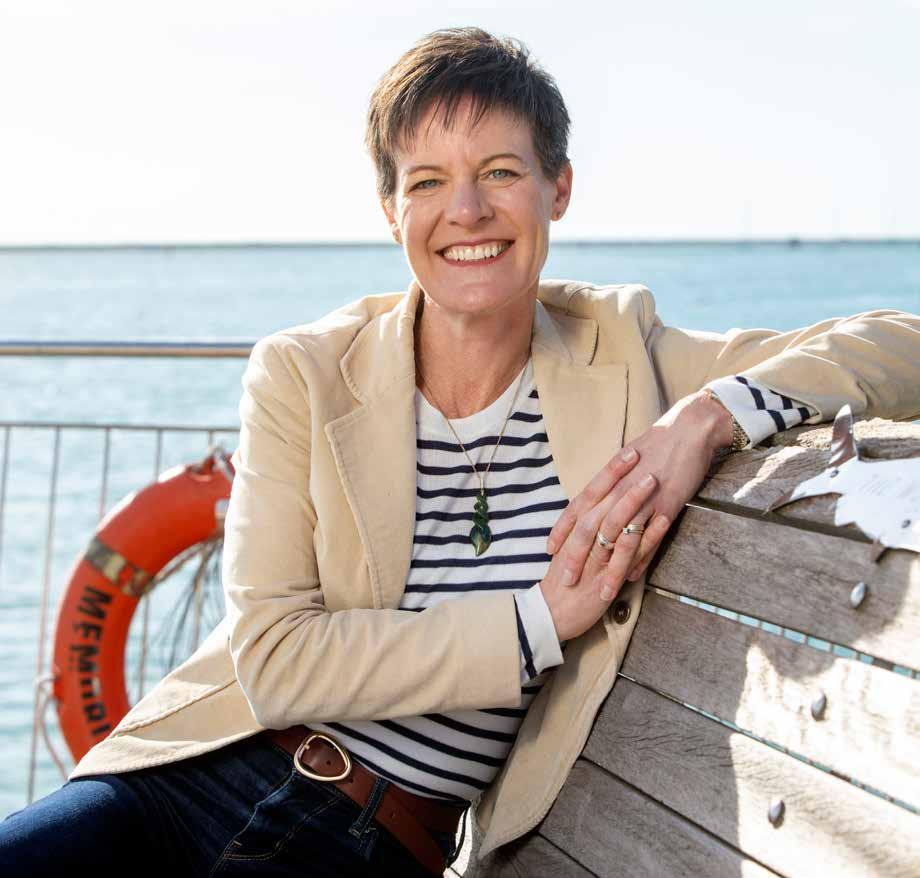

What does an aquarist do? Jo Percival finds out.
BRINGING THE OCEAN indoors is no easy task, especially when the indoor setting is a repurposed sewage treatment plant under a busy Auckland road. However, SEA LIFE Kelly Tarlton’s has got the process down to a fine art, having operated the full-scale aquarium underneath Tāmaki Drive for nearly 40 years.
Today, 21-year-old Jenna Van Ginkel is one of the 15-strong team of aquarists at SEA LIFE Kelly Tarlton’s whose responsibilities include caring for the diverse underground marine environments and all their inhabitants.
Having graduated with a degree in marine biology from Auckland University, and with a deeply engrained passion for the ocean, Jenna landed her dream job at the aquarium a year ago.
“I have been fascinated by the sea for as long as I remember,” Jenna says. “I grew up in Singapore which doesn’t have such an accessible marine environment as Auckland, so moving to New Zealand six years ago it was all suddenly at my front door. I can go snorkelling at any beach and see so many things, which I think a lot of New Zealanders take for granted.
“The sea is so vast and there are so many different environments. From polar to tropical, and the sub-tropical regions like New Zealand, I just love everything about it.”
As an aquarist, Jenna’s job is to look after all the species of marine life in the aquarium. “We’re in charge of maintaining water quality for all the different environments,” Jenna explains. “Just like any other animal, we have to feed them and look after their environments, but we’re also in charge of the air that they breathe, essentially.
“In a way, having an underground aquarium makes things easier because
we can manipulate everything. But it also makes things quite challenging because we have to manipulate everything!”
Every day Jenna and the team dive in the tanks to feed the fish, sharks and rays. “The eagle rays and the sharks are my favourites. They all have their own distinctive personalities. When I first started working here, I wondered how I would tell them apart, but once you get to know them you can understand their quirks and personality traits.

through the trap door on the Tāmaki Drive footpath, or via a hydraulic hoist that descends into the aquarium space.
The aquarium also has to bring in all of the water required to create each individual marine environment – from the 25°C tropical tanks to the chilly 12°C needed for deep water species. For this, the waterfront location certainly has its benefits. “There’s a pump under Ōrakei Wharf which brings water into our building,” Jenna explains. “We replace
The eagle rays and the sharks are my favourites. They all have their own distinctive personalities. When I first started working here, I wondered how I would tell them apart, but once you get to know them you can understand their quirks and personality traits.
“Rua is the biggest Sand Tiger shark that we have, and the only female. From outside the tank, the glass makes her look almost 30% smaller than she really is. So, when she first came towards me and I was holding fish it was a little daunting! But she is so gentle.
“We’re one of the only aquariums in New Zealand that hand-feeds sharks. It’s beneficial as it provides stimulation for them – they can choose whether they come to us or leave us alone if they’re full. If we just throw food into the water, we can’t see who’s eating what and it can also make the water dirty. Plus, because we’re underground there’s not much space for other ways of feeding.”
Accessing the shark tanks is just one component of the complicated logistics that come with operating in an underground space. Everything from building materials and café supplies to giant sharks has to come in either
all the water in the tanks every day. Once it has been in the tanks, we re-filter it before pumping it back into the ocean.”
Behind the scenes, SEA LIFE Kelly Tarlton’s has massive water treatment tanks, filtering and preparing seawater for each unique environment; 450 litres of water moves around the building every second.
As well as daily housekeeping, including cleaning glass and vacuuming the tanks, Jenna’s role involves interacting with the various marine species on site. The giant crayfish in the Sea Cave Adventure zone are as friendly as dogs, she says – they’ll climb on top of her when she’s in the tank.
As do the short tail stingrays – Penny, Barbara and Molly. “Whenever we go into feed them, they bowl into us and almost topple us over,” she laughs.
“I’m constantly learning things here –every day. We’re continually evolving and upgrading. It really is my dream job!”
“OVER THE YEARS I’ve found it hard to get rid of my surfboards,” Simon Kaan confesses. “They’re like taonga to me. My partner Sarah tries to turn a blind eye but sometimes hints that maybe I should get rid of some from our basement. So, I send a few of them to live with friends and family.”
The Dunedin artist owns around 40 of them, a hoarding that reflects the depth of his ocean love. It may also be Simon’s way of compensating for the first makeshift surfboards on which he learnt his sea-craft in the 1970s.
“My dad used to get big bits of polystyrene from the fish factory down the road in Sawyers Bay. My two brothers and I would snap them in half and share them. We’d go to Aramoana Beach with the family, have a surf and get some cockles. We never knew what the waves would be like – we’d just rock on up and jump in the water with no wetsuits and a couple of bits of polystyrene. It made us hardy.
“Our bodies would be rashed-up like sandpaper from lying on it in the cold water all the time. It was like torture. But it was all about getting to love the ocean.”
He eventually bought a wetsuit – which saved him some skin, but it didn’t offer much in the way of temperature control. “The wetsuits were so cold back then. I remember once putting a ski jacket on over top – I nearly drowned because it just filled up with water.”
Four decades on, Simon still surfs at Aramoana, but these days he’s coddled by thick, chill-thwarting neoprene rubber – though that tends to make the moment when you peel your wetsuit off all the more withering.
“Aramoana is sometimes referred to as the coldest car park in the world. You’ve got that brutal southerly in the winter with a wind chill factor that can bring the temperature down to two degrees or colder.”

It isn’t enough to keep him away from Aramoana though. “It’s one of the best beach breaks in the country when it’s good. When it gets swell, it’s the only place I’ll drop tools for and bolt on meetings and other responsibilities.”
Today’s detailed meteorological forecasts have helped minimise the need for sudden tool-dropping.
“Back in the day we’d race home to watch the six o’clock news for the only weather report of the day. Now we’re updated 24/7 with 10-day forecasts, so I can plan meetings around high tides, low tides or offshores.”
Asked what a dedicated Dunedin surfer puts up with, body-wise, Simon says, “An elderly one like me? My knees. My shoulders. Surf injuries. I’ve got about 98% bone growth over both my ears from surfing. It’s diminished my hearing and I get ear infections, so these are prices you pay.”
But it’s still worth it. “It’s that engagement with the ocean, with the energy of a wave – you feel like you’re part of it. Really good surfers become an extension of the wave.”
Given that the Dunedin coastline is so heavily imprinted on Simon’s psyche, it’s not surprising that it shows up in his art practice. The visual vocabulary of the ocean has long dominated his paintings and prints, and in recent times he’s taken it one step further by painting on fibreglass surfboards.
“My art is often a kind of pause – like you get when you’re out in the water. I spend a lot of time on my surfboard waiting, eyeing the horizon. I’m always observing colour, translucencies, the relationship between the water and the sky.”
Now in his 50s, Simon’s content with two or three surfs a week. “I did the maths and worked out that at an average of 20 waves a week for 40 years, I’d probably surfed 40,000 waves. So I’m now happy just getting the waves I get, rather than wanting more and more.”
Of surfing’s tug, Simon says: “I can’t imagine not doing it. It’s a ritual, it grounds me. My grandmother used to call it my church – she’d say, ‘are you off to church again, Simon?’ She was a wise old thing.”





Lynnette Day and her 1983 Honda CRX Ballade Sport.
“I FOUND THE CAR on TradeMe a couple of years ago and instantly thought ‘I have to have that!’ Firstly because it is red, but I could also see that it was a good investment because it is very rare.
I fell in love with the design. That’s more or less what I look for with most things in my life. It’s hard to explain because it’s not a tangible thing, but when you look at it side-on with the little chopped off rear end and the sleek bonnet, that’s what really appealed to me. It’s got mag wheels at the moment because I’ve taken the originals off to be restored. The mag wheels make it look a lot more modern than it really is.
I get so much interest in it wherever I go. I get men of a certain age giving me their business cards, just in case I’d be interested in selling it. I drive it on weekends and holidays – not every day. It’s a classic so it stays in the garage. It’s actually pretty terrible to drive! There’s no power steering, which of course we take for granted these days, so corners are no easy task. But apart from that it’s very nippy; you just don’t want to do too many tight turns.
The interest it creates is really astounding. She’s a little beauty.”
Are e-scooters the way to go? Vanessa Trethewey reports.
Since Lime rental scooters burst onto the scene in 2018, e-scooters have taken New Zealand by storm. Now an accepted part of life in many of our towns and cities, they are used by everyone from high school students to senior citizens, executives, tradies and public servants. And with good reason. They’re a convenient way to get from A to B, they’re accessible, easy to park, and they’re relatively environmentally friendly. E-scooters are helping make our cities more liveable.
But there are, inevitably, a few issues with them. When ridden without enough care or consideration, they can be a hazard for pedestrians. And accidents, when they happen, can have nasty consequences.
Between 2021 and 2023, more than 7,000 e-scooter injury-related claims were lodged with ACC, with a whopping 37% increase last year. This year, between January and June, 1,830 new claims were made –although it should be noted that in that same period, 12,000 new claims relating to car or motorcycle accidents were made. The main group of people experiencing e-scooter related injuries and incidents are New Zealand European/Pākehā males aged 20 to 40, and there is a higher rate of hospital admission among those renting their e-scooters compared to those riding privately owned scooters.
Most of us likely know of at least one person who has injured themselves riding an e-scooter, with levels of injury ranging from bumps and bruises to broken bones, life changing head injuries (the concussion rate runs at about 50 incidents each year) and, in five
cases, death. Studies show that helmets are the single most important way for riders to protect themselves, but while they are becoming mandatory in a growing number of places around the world, in New Zealand helmets are still just ‘recommended’.
There is some good news, though. Although the number of claims has shot up, the overall claim cost each year has fallen; essentially, as e-scooters have become more widely used here, the severity of injuries has lessened.
As the popularity of e-scooters is likely to grow, what can we do to boost safety and help ensure the downward trend of injury severity continues? Chris Rodley is the National Manager for Regulatory System Design at NZ Transport Agency Waka Kotahi (NZTA) and he says education plays a key role.
“That is something NZTA is currently working on, starting with retailers, so customers can be informed from the beginning.” As many e-scooters are privately owned, this seems like an excellent place to start.
“Recently, we reached out to more than 40 e-scooter and micromobility retailers across the country because we wanted to make consumers aware of the rules that relate to their purchase,” Chris says.
The Land Transport (Road User) Rule 2004 outlines how riders must behave, including being ‘careful and considerate’ when riding on the footpath, not going too fast, and giving way to pedestrians and drivers of mobility devices. The E-scooters (Declaration Not to be Motor Vehicles) Notice 2023 sets out the requirements for the e-scooters themselves.

“The Notice exempts e-scooters that meet certain criteria from being classified as motor vehicles, which means they don’t need to meet motor vehicle standards or be registered, they don’t need number plates, and riders don’t need to have a driver’s licence to operate them.”
How do you know if your e-scooter meets these regulations? Chris explains: “It must have a footboard, two or three wheels, and a long steering handle. Its wheels can’t exceed 355mm in diameter and it has to have one or more electric auxiliary propulsion motors. Also, its maximum power output can’t exceed 300W; if it does it’s classed as a motor vehicle, and since e-scooters don’t comply with motor vehicle standards and technical requirements, it can only legally be used on private property. Plus, you’d need to be licensed to drive it, and there are no licences for high-powered scooters.”
So, once we have ticked all those boxes, are we free to ride our e-scooters anywhere? Well, not exactly.
“E-scooters can be used on footpaths and roads (as near as possible to the edge), but not in cycle lanes. Only bikes are allowed in cycle lanes and cycle paths; however, e-scooters can use shared paths.”
That could change. Consultation on potential regulatory changes to enable e-scooters to use cycle lanes and cycle paths was undertaken as part of the Accessible Streets package in 2020 although, so far, no decisions have been made. For now, e-scooter enthusiasts need to stick to the footpaths or roads, make sure their scooter meets legal requirements, and brush up on the safety rules.
The AA strongly recommends that e-scooter riders wear helmets.
Keep at a safe speed and slow down when you’re near people. It’s illegal to ride at a speed that’s hazardous to people.
Always give way to other people on the path. You might have to come to a complete stop or dismount if the path you’re on is busy.
Keep left, unless you’re passing. Only pass people if it’s safe and pass them on their right.
Be aware of who’s around you – people move unpredictably and may not know you’re there.
Always leave a safe distance between you and other people.
The AA would like to see
Helmet use to be mandatory.
E-scooters to be allowed on cycleways and shared paths, with speed limits.
An age restriction of 16 years to apply to those riding e-scooters on a road.
Rules around riding under the influence of alcohol or drugs, and not using cellphones, to be in place.
Regulations relating to safety when riding at night, such as lights and reflectors, applied.
Is our driver licensing system up to scratch? Matt Tso investigates.

Since 1987, New Zealanders have learned to drive under a graduated driver licensing system (GDLS). Designed to develop safe habits among novice drivers, the three-stage approach to obtaining a full driver’s licence was an improvement on the older system which was shorter and less demanding of candidates. However, while the current GDLS is considered effective, it’s not perfect.
Inexperienced drivers can be expected to make mistakes, occasionally with serious consequences. Young people aged 15-25 were involved in nearly 30% – 96 of 337 – of fatal crashes in New
Zealand in 2022; they were thought to be responsible for 82 of them. These statistics raise questions about how we prepare new drivers, and how we compare with other countries.
The AA Research Foundation recently commissioned a study by the University of Adelaide’s Centre for Automotive Safety Research (CASR), which benchmarked New Zealand’s GDLS against overseas schemes. The study identified measures with beneficial outcomes for novice drivers that could be used to strengthen New Zealand’s licensing system.
AA Communications, Research and Road Safety Manager Dylan Thomsen says the
study is a useful starting point for finding licensing areas that might be improved.
“We know that New Zealand has more road deaths than many other countries and under 25-year-olds have the highest crash rates. This research highlights some of the approaches other countries take to new drivers getting a licence and asks if we could be doing things better.”
Different approaches to licensing overseas include:
Extended learner periods: Most Australian states have a minimum learner period of 12 months – double New Zealand’s –
Before the end of the year the Government is due to set out its priorities for road safety for the next three years. The AA believes the timing is right to run New Zealand’s licensing system under the microscope as a part of this process.
which gives novice drivers more time to accumulate supervised driving experience and develop safer practices.
Mandatory supervised driving hours:
Several countries require learners to complete a certain number of supervised driving hours before being able to drive alone. Most Australian and US states require 50 to 120 hours (including night hours) which help drivers gain experience under different conditions. More time behind the wheel as a learner is acknowledged to improve a driver’s readiness for solo driving. A Swedish study showed novice drivers with 120 hours of supervised driving experience were involved in 35% fewer crashes than those with 40 to 50 hours.
Hazard perception tests:
These are a prerequisite for progressing from a learner to a restricted licence in several jurisdictions, including in Australia and the UK, to enhance new drivers’ abilities to anticipate and react to potential hazards. The tests are undertaken in a safe environment such as a simulator or using video clips.
Zero blood alcohol concentration (BAC) limits:
In New Zealand, only novice drivers under the age of 20 are subject to a zero BAC limit. There is a zero-alcohol limit in all Australian states for learner and restricted drivers regardless of age.
Tougher penalties for traffic offences: In New Zealand, all licence holders accumulate the same number of demerit points before losing their licence. In Australia, novice drivers have a lower threshold and any offences stay on their record for a longer time period. Increasing the severity of penalties for traffic violations committed by novice drivers could act as a deterrent against risky behaviours.
Is it time for a rethink? Before the end of the year the Government is due to set out its priorities for road safety for the next three years. The AA believes the
timing is right to run New Zealand’s licensing system under the microscope as a part of this process.
Dylan says the study considers different ideas and approaches that are fundamentally about safety.
“The learner and restricted stages of the licensing system are the ideal time to instill practices and habits that will keep novice drivers and others safe on the road.”
Donna Govorko is the General Manager of Kaitiaki o Ara Students Against Dangerous Driving (SADD), a youth-centred charity that focuses on reducing harm on the road by promoting safe behaviour. She says staying on top of international best practice is vital to ensuring the safety of those going through the early stages of the licensing process.
“There’s no harm in potentially borrowing ideas from other systems that could enhance the skills and confidence of people driving on our roads.”
Donna and Dylan agree the overrepresentation of young people in crash data highlights the need to explore improvements for the licensing process.
Dylan says some of the methods identified in the AA Research Foundation study would make New Zealand’s GDLS more demanding. The benefits of changes would need to be balanced with drawbacks such as drivers having a slower and more costly progression through the system.
“We know some people already struggle to get their licence – not everyone has someone who can teach them, or they might not have access to a roadworthy car. It can be tough, so potential changes would need to be considered from all angles,” he says.
“Maintaining a system that is fair and makes driving easily attainable to everyone needs to be balanced with an ambition to create better prepared, safer drivers and reduce harm and death on New Zealand’s roads.”
See aa.co.nz/drivers for everything you need to know about driver training and driver licensing.
Minimum Age: 16 years
Requirements: Pass a computerbased, 35-question theory test on road rules and traffic signs. A minimum score of 32 is required to pass.
Restrictions: Must always drive with a fully licensed supervisor seated in the front passenger seat; must display L Plates on the vehicle.
Requirements: A driver may apply for their restricted licence after holding their learner licence for a minimum period of six months. They must pass a practical driving test that assesses basic driving skills. Restrictions: Can drive alone between 5am and 10pm; must
have a supervisor outside these hours; passengers are restricted to partners, parents/guardians, or someone for whom the licence holder is their primary caregiver.
Requirements: An applicant must have held their restricted licence for a minimum of 18 months to gain driving experience. If a defensive driving course has been completed, then an application can be made after 12 months. Drivers aged 25 years and older can apply after six months.
They must pass a practical driving test that assesses advanced driving skills.
Restrictions: None; full driving privileges granted.

With time, money, and a measure of commuters’ sanity all being lost in traffic jams in our most clogged cities, congestion charging is under the spotlight as a possible solution. The Government is set to legislate to allow for congestion charging, now known as timeof-use charging. The AA says a clear, fair balance needs to be struck between reducing traffic and keeping roads accessible to those who need to use them.
Time-of-use charging aims to cut traffic by introducing tolls on certain roads. Targeting discretionary trips at peak times aims to incentivise people to travel at different times or by other means, particularly public transport. Those paying to continue to drive will, in theory, benefit from faster travel times with fewer vehicles on the road.
Talks on time-of-use charging are most advanced in Auckland where the council is poised to develop a strategy soon, pending Government legislation. It has also been mooted in Wellington and Tauranga.
Congestion wastes time for road users and imposes significant opportunity costs on individuals and families. It also impacts businesses, and is estimated to cost the Auckland
economy over $1 billion a year. Historically, the response to congestion has been to build more roads, however that has become impractical in built-up areas due to geographical and financial constraints.
Improving public transport is essential, but it is a long-term solution that is likely to only have a minor impact on congestion in the short to medium term. That’s because New Zealand’s urban development has for the most part been driven by the mobility provided by cars, so both our homes and workplaces tend to be widely dispersed. This makes it difficult to serve most trips effectively and efficiently by public transport.
The AA is mindful that time-of-use charging has not been introduced anywhere that closely mirrors New Zealand’s low-density, car-centric cities. Those cities that do have congestion charging schemes in Europe and Asia have dense public transport networks that offer genuine, and often better, alternatives to driving.
Survey results of 16,000 Auckland, Tauranga and Wellington AA Members reveal considerable scepticism towards congestion charging. Fewer than one in three thought it should
be given serious consideration, with many having concerns about whether it would be fair, affordable, or effective; others felt such a scheme might be too focused on revenue.
When considering its position on congestion charging, the AA took into account the views of AA Members as well as the lack of precedents with time-of-use charging in similar cities. It has also considered the fact that congestion will only get worse with population growth, and that there is a lack of other meaningful solutions to address the problem.
We think the potential benefits from time-of-use charging unclogging our roads are substantial, but we are concerned that the costs could be significant for some people who will have no choice but to drive, particularly given the limitations of our public transport networks.
The Association is therefore open to, but cautious about the idea of time-of-use charging. Authorities need to address these concerns – effectiveness, equity, public support, and revenue allocation – before a case can be made for its introduction.
Congestion wastes time for road users and imposes significant opportunity costs on individuals and families. It also impacts businesses, with congestion estimated to cost the Auckland economy over $1 billion a year.
Effectiveness: The primary goal of congestion charging must be to reduce traffic congestion, not to raise revenue. Any proposal to introduce a scheme should clearly outline expected improvements in travel times and the impact on other roads.
Equity: Fairness is crucial. Charges should only apply when and where they are needed to minimise congestion, be set at the lowest possible level to achieve a reasonable reduction in congestion and reflect people’s ability to adjust their travel times or modes. Considerations like daily charging caps or targeted exemptions should be included in any proposed system to recognise that the toll is not about revenue, and to not disproportionately impact certain people.
Public support: Gaining public support is essential.
Comprehensive public consultation is necessary, providing transparent information about the impacts and benefits of any proposed scheme. The AA believes the final approval should rest with the Minister of Transport, based on public support levels. Ongoing monitoring and transparent reporting will be key to maintaining public trust.
Revenue allocation: Revenue from congestion charges should first cover the scheme’s setup and operating costs. Remaining funds should be reinvested in transport, first to improve both the effectiveness and fairness of the scheme and then to support broader transport improvements within the region.
The AA's ongoing stance on congestion charging will be shaped by the specifics of any legislation and proposed schemes. If New Zealand is to progress any congestion charging ambitions, it would need well-defined objectives in legislation outlining how people who pay the charge will benefit.



How to tow a trailer with confidence, by Kathy Catton.
From reversing a boat trailer down the ramp or loading up a caravan in the most balanced way, it takes practice to feel comfortable towing. But the rewards are the convenience and independence of moving large items yourself. Before hitting the road with a trailer, it is crucial to understand the legal requirements.
“It’s not just a case of going down to Bunnings and hooking up a trailer,”
Robert Wriesnik, AA Driving Instructor says. “It’s the driver’s responsibility to drive legally and safely.”
Towing a light trailer doesn’t require any special licence in New Zealand, so it’s up to the driver to ensure they have the correct knowledge and skills.
You’re legally required to ensure the trailer has a safe and strong coupling, with a safety chain or safety cable. There needs to be two white lights at the front
of the trailer showing how wide it is (if over two metres wide), two red reflectors and stop lights, indicators, a number plate and light, mudguards and safe tyres (with a minimum tread depth of 1.5mm).
If the load you’re carrying hangs over the rear of the trailer by more than a metre, you must attach a flag of 400 x 300mm.
The maximum speed when towing is limited to 90km/h on the open road; the maximum overall weight of a trailer plus towing vehicle on a class 1 full licence is 6,000kg.
To avoid your trailer swaying, make sure the load is evenly distributed to maintain a low centre of gravity, with the load placed towards the front of the trailer, ahead of the trailer axel.
“You need to be aware that overloading and uneven loading of trailers can seriously affect a vehicle’s handling,” Rob says. “Sway can occur, especially in
Give yourself more space and increase your following distances on the road.
Check your mirrors every few seconds.
Keep your turning radius wide. Pull over, when safe to do so, to let other traffic pass.
Avoid driving with a trailer in high winds and drive to the road and weather conditions. When reversing, use a spotter to help you.
Check your trailer, load and tyres at every break stop and check the wheels and brakes for overheating issues.
Park on a flat surface and turn your engine off.
Connect the tow-ball connection, apply the locking pin and secure the safety chain. Check the tow-ball and the coupling are compatible, as there are two sizes in New Zealand. Test the coupling by attempting to lift off the towball in place.
Plug in and test the electrical connection.
high winds or with sudden movements. To minimise sway, distribute the weight evenly side-to-side, make sure the trailer is level and the hitch connection is secure.”
If your trailer does start to sway, avoid making sudden steering movements or braking quickly. Ease off the accelerator
and gently apply the brakes. Once it's back under control, safely pull over to a stop and check your load distribution. Also, remember the added weight behind you means you’ll need more space to stop. “Increase your following distance from two seconds to four seconds,” Rob says. “Also, brake earlier to allow for the added stopping time required.”
When towing, you will be slower than other traffic. Check behind you often, and pull over at a safe place to allow others to pass if a queue is forming. One of the most daunting tasks for first-time trailer towing is reversing.
Go slow! Reversing with a trailer requires patience, so take your time and make minor adjustments when necessary. Align the rear of your vehicle with the starting point of the trailer’s desired path. Begin reversing slowly, gently applying the brakes as necessary. Remember that the trailer will move in the opposite direction of the steering input due to its pivot point.
Mirrors are your friend. Use your side mirrors to monitor the trailer’s

movement and trajectory. Adjust them to have a clear view of the trailer’s path. Even better, have a spotter assist you from outside the vehicle. Don’t hesitate to stop, get out and look to see where you are.
Steer opposite. As the trailer starts to rotate, steer in the opposite direction to where you want the trailer to go by focusing on the rear end of the trailer and steer by holding the steering wheel at the bottom. This might feel counterintuitive at first, but with practice, you will gain better control. If the trailer starts to jack-knife, stop the vehicle, pull forward and try again.


The Model 3 is the second best-selling EV in New Zealand, only slightly behind the Telsa Model Y. Earlier this year, a revamped version of the Tesla 3 was launched. The exterior aesthetic is sleeker and, as a result, slightly more aerodynamic. There are also a few interior innovations: cabin material build quality is better, a touchscreen for rear seat passengers has appeared, and door panels and seats have been reworked to improve sound proofing and interior acoustics. The Tesla 3 Highland also features a new self-adjusting suspension set up depending on the road quality and cornering speed. The result is a very smooth and composed drive, with minimal noise or vibration. Cost starts at $63,900.

Mazda offers the ultimate SUV driving experience, with two distinct engine options in its first all-hybrid range: the CX-60 3.3 Homura and the CX-60 2.5 PHEV, with exceptional performance in the PHEV. It pushes out an impressive 241Kw at 6,000 rpm and 500Nm of torque at 4,000 rpm. Plus, it travels up to 63km using only electricity, thanks to a 17.8kWh battery pack. With its combined fuel consumption of 2.3 litres per 100 kilometres, and only an approximate $6,000 leap to upgrade from the Homura (at $81,990 + ORC) to the PHEV ($87,990 + ORC) – it wouldn’t take long to see the fuel savings add up.

This is Mercedes-AMG’s first iteration of an EV in the SUV format and it offers a truly immersive driving experience with as much – if not more – tech and power than its petrol-breathing siblings. It has a more aerodymanic design (fewer boxy angles means better drag coefficiency and better battery range). But for a heavy and tall SUV it’s still agile, with minimum body roll. Also, thanks to rear axle steering, it has a supertight turning circle; a real asset for city parking. The opulent EQE comes with all the bells and whistles associated with the brand, including an interior package with ambient illumination, intelligent driver aids and a 56-inch dashboard ‘hyperscreen’. Cost with standard equipment starts at $201,900.
Think of the compact crossover SUV as sandwiched between small hatchbacks and medium SUVs; economical and practical, with increased visibility from an elevated driving position. The very stylish EX30 fits exactly into this segment. It’s deceptively heavy for a small car (nearly two tonnes), but the weight is balanced to provide comfortable and stable dynamics. The ride quality is excellent. The interior of the EX30 is unsurprisingly minimalist and the in-car acoustics phenomenal, thanks to a 1040-watt Harman Kardon soundbar stretching the length of the dashboard, two rear door speakers, and a subwoofer in the boot. Breathtakingly fast, pleasantly stylish and genuinely fun to drive, the EX30 Ultra starts at $78,990.


Previously owned by SsangYong, the KGM Torres is a mid-sized SUV with various powertrains, the first of which – a fully electric, priced at $67,990 – is in New Zealand now. It’s a ruggedly composed, contemporary vehicle with strong lines and a great stance. Handling characteristics are set up on the soft side, which suits city driving better than the open road. Range is stated at 462km, power is more than enough (0-100km in 8.1 seconds), and the front wheel drive drivetrain performs well. The Torres is a superb effort from KGM and those waiting for other brands to offer their bestselling petrol SUVs in electric format may now have a reason to switch alliance.

The new Jimny is 34cm longer, enough to give it two extra doors, comfortable rear seat legroom and ample boot space. It comes in five-speed manual or four-speed automatic. The 4WD system features Suzuki’s ALL GRIP PRO technology and both axles are rigid, with coil springs allowing for optimal articulation and off-road grip. The five-door comes with a re-designed front bumper for pedestrian protection, lane departure warning, collision detection camera (DCBS), sway warning, improved front and side impact absorption and ESP. Pricing for the fivedoor manual Jimny starts at $40,990 and $44,990 for the automatic. This is a $5,000 bump from the current three-door pricing.

Fuel economy ratings are available for these models. To compare fuel economy and safety ratings across other vehicles, go to rightcar.govt.nz
The AA Motoring Services team test-drives new models and makes of car. Their detailed, impartial reports are available at aa.co.nz/cars , along with ANCAP safety ratings.







50
Along the coast
A road trip from Nelson to Kaikōura explores the top of the South Island.
60
Carried away
Two memorable weeks cruising from Hong Kong to Tokyo.
64
Finding paradise
A cruise in French Polynesia on board the Aranui 5.
Barbara Kendall is a legendary windsurfer, three-time Olympic medallist and was recently made an Olympian for Life. Where is her favourite place for winding down?
“GREAT BARRIER ISLAND has been our family’s top spot for the last 25 years.
We sail out there every Christmas; it takes us five hours. Or eight hours if we go around the back way. When the weather gets a bit rough, we just go into Fitzroy Harbour and it’s pretty calm and safe. There are great spots for fishing, water sports, surfing and wind foiling. There are amazing bushwalks and beaches, and the DOC campgrounds are really beautiful, too.
One Christmas holiday, it rained the whole week. Living in a 32-foot yacht is pretty small with five of us! We’d go walking in the rain and then nothing would ever dry, everything stayed damp. We were pretty miserable, actually! We ended up coming home early, but that was the only time I remember that happening.
You’re at the mercy of the elements out there, but I think it’s the simplicity of it that’s great. Not having all your stuff, and not being at home with jobs to do. You can just decompress and chill out. And that usually takes at least a couple of weeks of not having responsibilities; no emails, no phone calls. Phone reception is really bad out there. That helps protect you from the outside world.
We’ve tried other places, but we always end up coming back to the Barrier.”
Fiona Terry finds treats and treasures on a road trip from Nelson to Kaikōura.
he English tourist could hardly contain her excitement. “I saw this place on TV a couple of weeks ago, I can’t believe I’m here!”
We were at Nin’s Bin, the roadside takeaway with a history as grand as its view of the Pacific Ocean and a menu that showcases crayfish freshly landed off the owner’s boat.
The iconic blue and white caravan has been a roadside feature north of Kaikōura since 1977.
Our road trip had begun in Nelson, Whakatū, with an early detour just 15 minutes after leaving the city, to check out Cable Bay. A small climb up the hill overlooking the sheltered bay led to an information panel with details of the origins of the tiny settlement’s name, so called after the telegraph link to Australia came ashore here in 1876.
En route back to the main highway were signs for a very different type of line – one of the world’s longest flying fox rides, at Cable Bay Adventure Park. The 1.6km-long Skywire speeds thrill-seekers across stunningly beautiful native forest.

We continued up towards the Whangamoa Saddle, slowing for every swing and hairpin, allowing time to soak up the beauty of the steep valleys and forested peaks.
At the turning for Ōkiwi Bay is a sign to Rai Valley Cottage. Dating back to 1881, its tōtara slabs, cut on site by Charles Turner, have weathered many storms with dignity. Now cared for by the New Zealand Historic Places Trust Pouhere Taonga, a glance through the windows of this characterful building gives a snapshot of Charles and his family’s life, with the table set for dinner and nightgowns airing over the bedsteads. By the time we’d reached Pelorus Bridge, we were ready for a leg stretch and strolled the short River Access trail through tall beech trees, small rimu and the chorus of cicadas. We came upon a family with small children who’d set up with boogie boards, lifejackets and shade on the stony bank alongside the clear, calm, emerald water.
At Havelock, we explored the tiny but fascinating museum, where Aunt Sally, a magnificent 1893 Barclay locomotive




stands guard outside. She was one of three engines used to carry native timber from the valleys, no easy feat considering that between 1864 and 1939, millions of tonnes of it were shipped from Pelorus Sound.
Every year this town fizzes with excitement as crowds gather to celebrate the Havelock Mussel & Seafood Festival. At the Slip Inn on the water’s edge, the greenshell variety features prominently on the menu. From the nearby jetty the scenic Mail Boat cruise departs, an attraction in its own right but also a lifeline which carries supplies to remote coves.
Driving on we passed fields of dairy cows, horses, and treefringed cottages with sunflowers as tall as their eaves. It didn’t take long though before the landscape of forestry and farming switched to a vista of vines.
Marlborough is renowned for its cellar doors, but it was Omaka Aviation Heritage Centre we’d pinpointed as an absolute must on this journey. Billboards outside detailed privately run airborne experiences, including a ride on the world’s last flying Avro Anson Mk1 WWII coastal reconnaissance bomber. This is the setting for the biennial Classic Fighters Omaka Airshow which, with a backdrop of the golden Wither Hills, draws crowds of tens of thousands.
We soaked in the history at this world-class facility, strolling first through the scenes in the Knights of the Sky exhibition, showcasing the development of aircraft through the Great War of 1914 to 1918. The planes on display are the personal collection of film director Sir Peter Jackson. The dioramas which help tell the stories behind the planes, were built with magical creativity by Wingnut Films, complete with incredibly realistic mannequins created by Wētā Workshop.

Alongside, the WWII Dangerous Skies aviation exhibition showcases static and flyable aircraft, including a Messerschmitt, Lockheed Hudson and de Havilland Mosquito.
Neighbouring this is Omaka Classic Cars, a collection of 115 original vehicles from what the owner calls “a special period of motoring,” the 1950s to 1980s.
Heading southbound, the road drew closer to the parched hills, slips revealed the friable sandy coloured land beneath the sun-bleached grasses. It seemed incredible anything could grow and yet we were still passing acres of lush vines.
Not far past the turnoff for Molesworth Station is Seddon, the heart of the Awatere Valley. Hawks soared above us as we wound our way through undulating fields of vines as far as the eye could see. A white limestone road led to the lookout with spectacular views towards the Marlborough Sounds, Cape Campbell and the North Island.
We continued on past a confection of pink – the landscape created by the saltworks at Lake Grassmere. Diverting off to Ward Beach, a stroll to the striking spherical rocks had me wondering why these curious geological features aren’t as well-known as the Moeraki Boulders.
On through the hills, it wasn’t long before we caught sight of the glinting blue ocean again, waves crashing spectacularly onto rocks out at sea, sending white foam and spray skywards. We were to follow this breathtaking view for many kilometres, flirting with the railway line that links Picton to Christchurch as we danced back and forth across each other’s path.





Tall cabbage trees became a familiar sight, with pops of colour from roadside red hot pokers glowing in the sun.
At The Store at Kēkerungū, the café’s barista was working flat out. Many patrons had set up at tables overlooking the lawn, neatly manicured and lined by agapanthus and karaka trees laden with berries.
This road offers not only a spectacular view of the ocean, but also an insight to the feats of engineering that enabled this route to re-open following the devastating 2016 Kaikōura earthquake. Giant metal canopies guard against falling rocks and at Ōhau Point Lookout a lengthy walkway offers a great viewing platform to the seal colony that calls this home.
As we pulled up, tourists were hurriedly piling off a coach to video seal pups playing in the rockpools, buffeted by surges from the pounding waves.
This road offers not only a spectacular view of the ocean, but also an insight to the feats of engineering that enabled this route to re-open following the devastating 2016 Kaikōura earthquake.
Wet-suited surfers enjoyed the swell further along the coastline. We reckoned they would be refuelling after their rides at nearby Rakautara, where Nin’s Bin was doing a roaring trade in whitebait patties. The excited English tourist I’d met was more interested in trying one of the fresh crayfish fetched in that morning. Such is the personal touch here that the business number rings through to the owner’s mobile even when he’s out at sea, for those wanting an update on the day’s catch.
As the road turned away from the coast, we saw that the scene inland was also spectacular, with the stunningly beautiful mountains of the Seaward Kaikōura Range rising sharply, Mt Fyffe standing proud.
Cruising into Kaikōura, the vast number of motels and hotels lining the highway were a telling sign of the draw of this whalewatching hub. We drove our plug-in Toyota to the end of the esplanade at Point Keen to find snoozing seals at the edge of the carpark. From here the Peninsula Walkway leads up across the hills to a viewpoint, but we agreed we would save that for another day. Like the seals, it was time for us to recharge.
Get discounts on your next road trip, from rental cars to accommodation, at aatraveller.co.nz


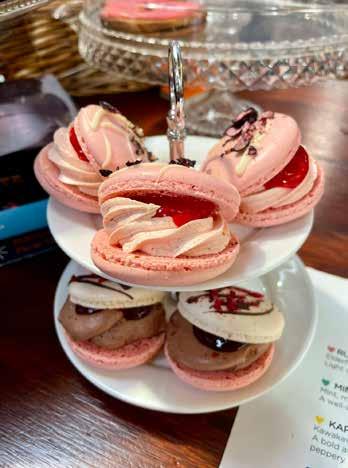

Tucked in the south eastern corner of the North Island between a wild coastline and the impenetrable Remutaka Ranges lies a valley of cultivated pleasures.
This is wine country. You could spend an entire weekend in Wairarapa and do nothing besides hop between vineyards, sampling Martinborough pinot noirs, and still only scratch the surface of the region’s vinous delights. But you’d also be missing out on the many other charms to be found here.
In contrast to the tidy vine rows further south, Pūkaha National Wildlife Centre at the northern edge of the region is wild. A pocket of native bush sits dark and mysterious in the surrounding emerald farmland. It’s a sanctuary for some of our most endangered birdlife.
Crunching along gravel pathways on a chilly morning, we linger outside enclosures to catch glimpses of the avian residents. New Zealand birdlife initially appears pretty low-key; it’s only when we stop and pay attention that we notice the subtelties of colour and sound.
A pair of aptly named saddleback, or tīeke, flit at a blink-and-you’ll-miss-it pace through the undergrowth, yellow crowned kākāriki chirrup and cling curiously to the cage mesh to watch us, russet kākā are unperturbed by our up-close gazes and, inside, under the red lights of the nocturnal house I spot the rump of a kiwi, looking like a toupéecovered rugby ball.
On a sunny Saturday, Aunt Ginger’s Kitchen in Carterton is packed. Stepping inside, it’s easy to see why. The array
of cabinet food is as photogenic as it is enticing. We drool over mini cheesecakes and macarons but opt for a moreish jalapeño cheese scroll since the famous cheese scones have already sold out.
In the heart of Wairarapa, we stop in Greytown, a pretty village popular with Wellington shoppers on the hunt for scents and clothes and homewares and art. We smile at curly-coated dogs on leads as we dip in and out of shops. Further down the road, biscuit-tin Victorian cottages sit behind white picket fences.
In contrast to Greytown’s cottagey cuteness, Alexia Winery, set just off the main drag, is a utilitarian concrete block building, an urban winery. Owners Jane Cooper and Lesley Reidy are hands-on, talking with guests, running food and selling bottles from the cellar door. Jane


has been making wine for more than 30 years and Alexia is the embodiment of her knowledge and passion. She tells us how changes in climate have pulled forward vintage by several weeks over the last few years, while we sip samples of tart Grüner Veltliner and a white pinot noir with just the smallest hint of blush.
A cloudless morning sees us heading towards the southern end of the North Island when we’re forced to pull over, feeling like our eyes are playing tricks. On the blue horizon sits a mirage: it’s the snow-capped peaks of the Southern Alps floating like a dreamland. The day is so clear it provides an inadvertent lesson in geography as I pull up a map on my phone and realise that we’re actually standing further south than Blenheim.
We drive the crumbly coastline to Cape Palliser – officially the southernmost point of the North Island. Offshore, a breeze spikes rainbow mohawks in the surf. The ocean is benign today, but in inclement weather it gets wild here, and the sea gnaws chunks off the coastline.
Cape Palliser lighthouse, with its candy cane stripes, emerges like a chess piece on the headland. We climb the 250 dizzyingly steep steps, holding wooden handrails smoothed by thousands of nervous palms.

You could spend an entire weekend in Wairarapa and do nothing besides hop between vineyards, sampling Martinborough pinot noirs and still only scratch the surface of the region’s vinous delights. But you’d also be missing out on the many other charms to be found here.
At the foot of the lighthouse, buzzing from a boost of endorphins, the majestic coastal view is slammed in our faces by a stiff breeze. I drink it in.
In contrast to the invigorating coast, our afternoon endeavours are of the refined vinous variety – sampling wines and produce at The Runholder. A collaboration between two vineyards, a distillery and restaurant, packaged in a purposebuilt restaurant and tasting room, The Runholder is a decadent spot. We linger over a long, late lunch in the sunshine.
Another provider showcasing local produce is C’est Cheese – the epicentre of puns and dairy products in the quiet town of Featherston. Owner Paul Broughton explains how organic milk is delivered to the onsite factory from farms just 20 minutes down the road.
The shop showcases New Zealand-made cheeses including his own Remutaka Pass Summit Snow brie, which won best brie in New Zealand a few years back. We leave with a belly full of samples and a generous pile of cheesy wedges to take home.
While in Featherston we explore the Fell Museum, which tells the story of the remarkable engineering efforts once required to reach Wairarapa from Wellington. The museum is also home
to the only remaining Fell engine in the world. Designed to traverse the steep 1:15 gradient of the Remutaka incline, these squat little engines were the rail equivalent of tugboats, hauling carriages up and down the hills that were impassable for standard engines for 77 years between 1878 and 1955. We learn that the cast iron brake blocks used to grip a centre rail in the tracks would only last one trip – the six tonnes of pressure causing them to be red hot and worn thin at the end of each journey.
From the history of the gnarly Remutaka Incline to the untameable coast, this little pocket of New Zealand has always required effort to reach. But it’s certainly worth the effort.
We have a weekend in Wairarapa prize to give away. See p.14 for how to enter.



High above Fiordland’s Dusky Sound in a shaded tangle of Southern beech trees and primeval ferns, an intriguingly precise array of stumpy mounds covered with moss and lichen is all that remains of a significant event in New Zealand’s European history.
In March 1773, after spending three months at sea, including a perilous period avoiding icebergs south of the Antarctic Circle, Captain James Cook and the HMS Resolution entered Dusky Sound and anchored in a sheltered cove south of the forested island of Mamaku.
Initially making their way ashore along the horizontal bough of a rimu, Cook’s scientific team climbed high above the bay, set up a super-accurate H4 chronometer on wooden posts – now reduced to a circle of mossy stumps – and calculated New Zealand's longitude for the first time.
Compared to the Resolution squeezing 118 sailors onto a sturdy 34m-long barque, our own visit almost 250 years later onboard Fiordland Discovery’s Fiordland Jewel is far more comfortable. The 24m luxury catamaran comprises just 18 passengers and six crew members. Walking on well-maintained boardwalks to experience the hilltop knoll now known as Astronomer’s Point, contemporary visitors can avoid the forested scramble undertaken by Cook’s crew. Meals on the Jewel regularly team Fiordland kaimoana – including crayfish, pāua and scallops –with Kiwi craft beers and Central Otago wines. There's also an onboard hot tub to ease into after bushwalking, kayaking,


or journeys on the boat’s tender to learn more about Fiordland’s early Māori and European history.
Exploring Cook’s legacy in the most remote of New Zealand wilderness features half-way into Fiordland Discovery’s six-night southern Fiordland itinerary, a bucket list experience kickstarted by the thrill of landing on the boat’s upper deck after a 45-minute helicopter flight from Te Anau.
Skippering the Fiordland Jewel on its journey north from Preservation Inlet to Doubtful Sound is Fiordland Discovery’s co-owner Rob Swale, hugely experienced after growing up in New Zealand’s southernmost region, and with an adventurous CV including stints as a crayfisherman. While training as a multisport athlete, he also used to steer his sea
kayak around the region’s rugged and serrated coastline.
Rob’s also a man with a laconic sense of understated Kiwi humour.
“We're in Useless Bay now. It’s named after my kids,” he deadpans as we cruise through Preservation Inlet.
Apparently, Cook wasn’t a fan of the arcing cove at the southern tip of Te Awaroa (Long Sound). When we encounter a pod of bottlenose dolphins surfing on the Jewel’ s bow wave, the British mariner’ s prosaic epithet seems wildly inaccurate.
Cruising life aboard the Fiordland Jewel evolves to a relaxed routine. Rob’s versatile crew of deckhands, nature guides and chefs work hard on a variety of tasks; morning and afternoon baking fresh from the galley fuels regular excursions off the boat. Below decks,
picture windows in the Jewel’s cabins showcase a cinematic scroll of the same untouched scenery experienced by Cook and his crew on the Resolution
We journey by tender across Preservation Inlet to Kisbee Bay, once the location of the 1890s coal-mining settlement of Cromarty. A kekeno New Zealand fur seal is patrolling a sandy spot on the beach, but our destination is Preservation Lodge, a hunting and fishing retreat. It’s a sprawling and rustic spot, made distinctive with garish kaleidoscopic carpet and mismatched 1970s furniture. Framing the walls of the lodge’s high-ceilinged dining room, facsimiles of old maps – including Cook’s famous rendering of New Zealand following his earlier 1770 voyage on HMS Endeavour – reinforce the fact we're not the first to visit here, but Kisbee Bay feels wonderfully quiet and remote.
Before heading out of Preservation Inlet to tackle the open waters of the southern Tasman, we embark on a six-kilometre return walk to the compact lighthouse at Puysegur Point, rebuilt in 1943 after the 1879 original was destroyed by arson. From the point’s elevated location, the ocean swell rolling in from the southern latitudes of the Roaring Forties is benign.
The following morning it’s time to exit Preservation Inlet and head north. Rob anchors the Jewel just past the white cliffs of Chalky Island, another of Cook’s matterof-fact descriptors. Cobalt waters descend

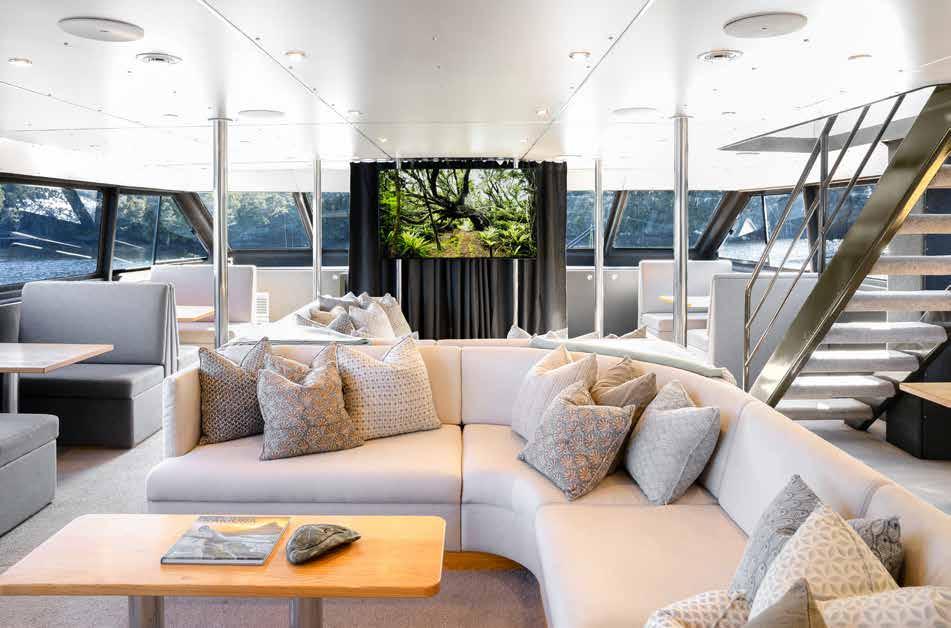
to depths of 150m, but the telltale zip of electric reels makes it easy for everyone on the boat – even fishing newbies – to secure hapuka, groper and blue cod. Argentinean chef Fermin Perez Nanni lands one of the biggest fish and is soon back in the Jewel’s galley transforming the bounty into dinner. Some smaller fish are thrown back and are quickly seized upon by a squabbling squadron of gulls, mollymawks and albatrosses.
Continuing north past West Cape, another uninspired moniker bequeathed by Cook, the Jewel swings northeast to enter Dusky Sound. Supporting the Resolution’s astronomical calculations high above Pickersgill Harbour, Cook’s vessel stayed in Dusky Sound for five weeks, the crew recharging and reprovisioning after sub-Antarctic sailing, and exploring more narrow channels by longboat. Our own Dusky Sound adventures include a bush walk on the predator-free kākāpō sanctuary of Anchor Island and kayaking through indigo waters around the sheltered arc at Sportsman’s Cove. For the crew of the Resolution, Sportsman's forested arena was an opportunity to race longboats; our late afternoon action is far more relaxed.
Exiting Dusky Sound via the slender Acheron Passage, Doubtful Sound is reached following another shorter spell in the open ocean. Still blessed with glowing blue-sky weather, Rob steers the Jewel north on a careful path a few hundred
Cobalt waters descend to depths of 150m, but the telltale zip of electric reels makes it easy for everyone on the boat – even fishing newbies – to secure hapuka, groper and blue cod.
Overnight experiences on Milford Sound and longer two- to nine-night adventures exploring Doubtful Sound, Fiordland or Stewart Island are also offered on the Fiordland Jewel by Fiordland Discovery.
See fiordlanddiscovery.co.nz
metres off the coast, and we anchor amid the calm waters of the Shelter Islands at the entrance to the sound.
The Resolution never actually entered Doubtful Sound in 1773. Cook named the waterway Doubtful Harbour, as he was not convinced a ship could navigate out again on winds made precipitous by the soaring cliffs.
On our last day on the Fiordland Jewel we see what the crew of the Resolution missed out on.
Squally showers sweep into Doubtful Sound from the Tasman Sea, shapeshifting banks of mist cling to granite peaks and by mid-morning, the quicksilver waterfalls tumbling down cliffs and forested hillsides have fired up amid the spectacular meeting of land and sea known to Māori as Patea –Place of Silence.


We have a six-night Fiordland Southern Fiords cruise for two, travelling aboard Fiordland Jewel, to give away. See p.14 for entry details.














































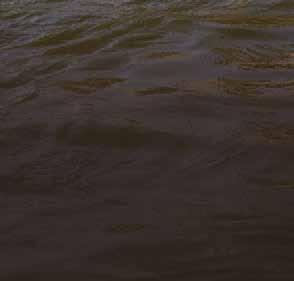
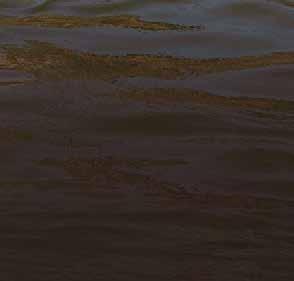





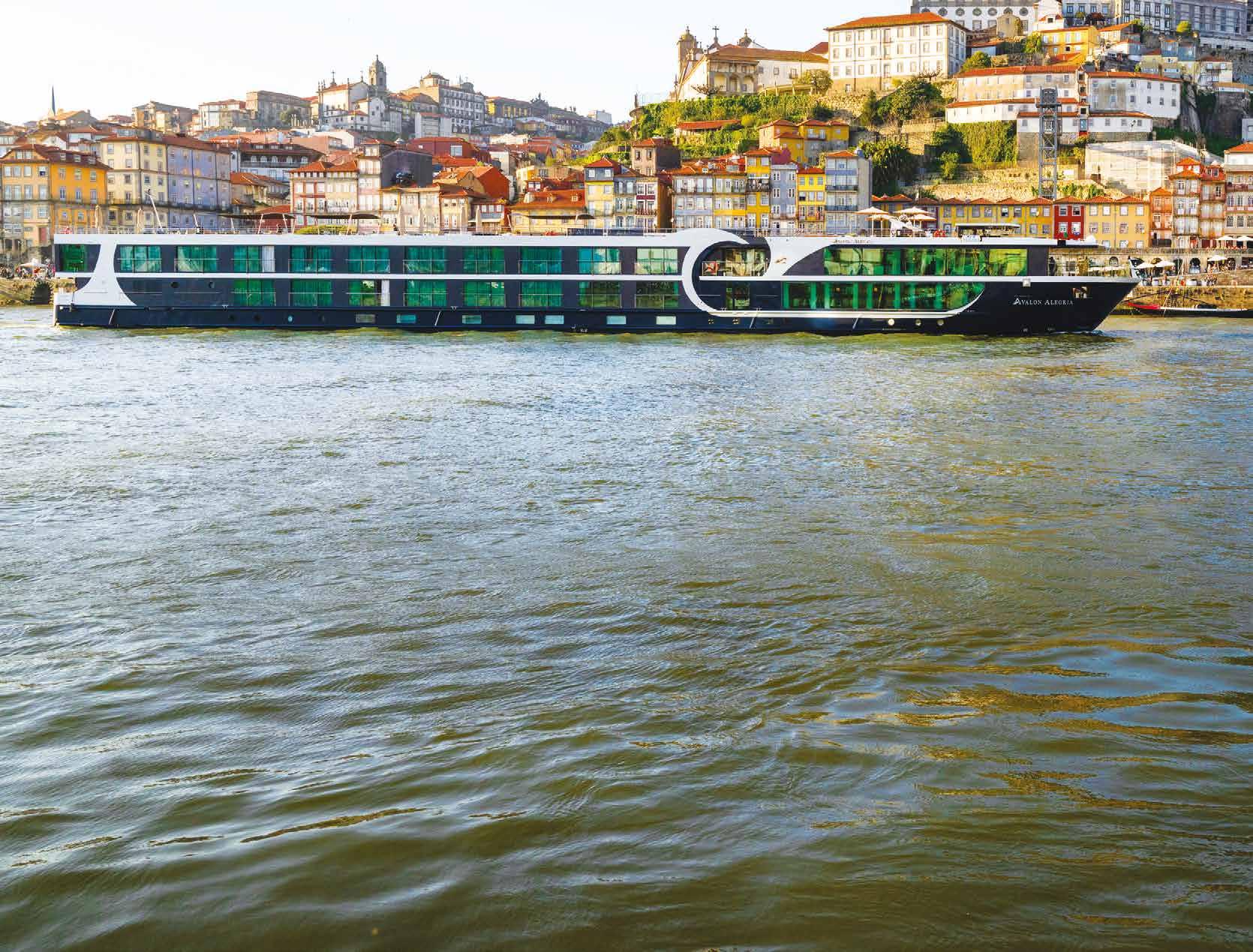

Kathryn Webster spends 14 glorious days cruising from Hong Kong to Tokyo.
Ballroom dancing, between 6 and 7pm in the Rolling Stones Lounge, catches us by surprise. We’re exploring the ship, familiarising ourselves and, drawn to the music, find the dancers. They are couples in their 40s, 50s, 60s, just a handful of them, taking a turn around the floor. Other people watch so we sit, too, and let our hearts be warmed by the scene. For many of these couples, this cruise is their chance to spend solid time together. As well as experiencing new places and having every possible need taken care of, they are reveling in special, focused time together. What other holiday would accommodate a love for ballroom dancing every evening?
For other passengers it’s other forms of dance, fitness classes, art classes, mahjong, wine tasting. Some will spend hours reading, watching movies, indulging in spa time, tracking the journey of the ship as she moves
through the Taiwan Strait – 650 nautical miles from Hong Kong, another 250 to Shanghai, up the Yangtze River – before heading to Japan.
According to the mats inside the lifts that are changed each day so we can keep track, today is Monday. That makes it day three of a 14-day cruise aboard MS Westerdam, one of the Holland America Cruise Line’s fleet, a big ship with around 2,000 passengers. I was a bit worried about the size of it; would it feel impersonal, crowded, unwieldy? No. It’s a good mix of privacy, splendour, intrigue and comfort.
In Shanghai, the cold seeps into our bones. The sky is close; it’s winter here. As this is our first time in Shanghai, the friend I’m travelling with and I opt to join a shore excursion. There are several to choose from; we go for an introduction to the city that takes us by coach to an excellent museum and then to a touristy but beautiful heritage village with a
classical traditional Chinese garden; gnarly-limbed trees, rocky shrines, carvings of dragons and bridges reflected in water. We meander for a couple of hours, there and in the surrounding shops, buying silk scarves.
On the second day in Shanghai, we wander the city’s famous riverside bund where families pose for photographs with a backdrop of skyscrapers disappearing into low cloud. Along a pedestrian-only street we find shops dedicated to nougat, souvenirs, clothing brands.
Cold, we decide to head ‘home’ and catch a shuttle back to the ship. While it is thrilling and exciting to be in a new city, it's also exhausting, and is a relief to climb the gangway.
The onboard exploration continues: the library is excellent, and I just know I will sit in the art-laden Gallery Bar with a book and a red wine at some point. The spa is a beautiful area – all gleaming tiles and nurturing perfumes. We’re tempted by hot rocks, seaweed wraps and steam room treatments. Now is the time to do such things, to take such treats. When else does anyone have time to have pedicures or acupuncture?
Other things to indulge in, if that’s the word, are pilates and yoga classes in the fitness centre, along with lifestyle consultancy. Now’s the time. Finish the cruise looking ten years younger!
Shanghai is so cold, we can’t bear to stand in the breeze of the aft deck as the ship departs, so we sit in the bubbling hot tub to watch the city lights disappear. We don’t take for granted the decadence of this; every such special moment is noted, gratefully. ‘Can you believe this?’ we ask each other. We’re sitting in a spa, on a ship, leaving Shanghai!
Departing Hong Kong had been even more magical because it was the beginning of the adventure. Also, Hong Kong has the most skyscrapers of any city in the world, so it was gloriously lit-up, a sparkly diamond wonderworld of earth-bound stars caught in boxes.
On a day at sea between Shanghai and the first port in Japan, we attend a lecture about the customs of Japan and another on the history of Korea.
Port talks, which describe the basics of the places we are visiting, how the trains work and where money can be exchanged, prepare us for some independent explorations. While there are always lots of tempting shore excursions available, choosing to explore independently is supported with shuttles and advice. And all the potential stress of immigration is cared for, too; everything is explained and organised in advance.
I walk four times around one of the open decks, clocking up a couple of kilometres to enjoy the evening light on the ocean as the sun slides toward the horizon. It’s been a smooth sail, so far, with very little wobble underfoot. A small flock of gulls has followed the ship from China. Occasionally there’s a freighter in the distance, otherwise it’s just us out here, a small town afloat by magic and ploughing through the day and the night, and another day to the next place.
Standing on the wharf is a man waving a flag. It’s early morning, it’s cold, but this man has come to welcome us to Kagoshima. Others join him, some walking
their dogs in the harbourside park, stopping to watch us tie up, disembark, trek off.
In the terminal, a group of volunteers invite us to take origami gifts.
Kagoshima, on Kyushu Island, is bathed in sunshine. Super excited to finally be in Japan, we stride out and with a little local help, sort some cash from a machine in a 7-Eleven, then navigate the bus system to visit Senganen Garden. Across the harbour looms Sakurajima, an active volcano complete with a steady plume of smoke from its peak. Young newlyweds pose for photographs in the gardens. They’re wearing traditional
Before reboarding the ship we walk around a harbourside park where people photograph the ship and, as we go to board, people are waving. A young woman is even fake-crying. There is a performance as we leave – a drummer and singing dancer on a small stage; as the ship pulls away, locals call ‘bye, bye!’
For a treat, we go to the Pinnacle Grill for dinner. Three courses at a set price include massive shrimps, scallops, crème brûlée; it’s a fine dining experience, in a quiet and sophisticated setting. We’re more in the casual camp than the formal, so opt most evenings for the Lido Market
The spa is a beautiful area – all gleaming tiles and nurturing perfumes. We’re tempted by hot rocks, seaweed wraps and steam room treatments. Now is the time to do such things, to take such treats.
clothes and hold cat masks to their faces.
In the late 16th century, seven cats from Kagoshima were taken on a military expedition to Korea as timekeepers. Apparently – I did not know this – a cat’s eyes change during the day. Early in the morning their pupils appear round; at noon they are like needles, contracting and dilating depending on light levels. The seven time-keeper cats – and those who came after – are honoured in a cat shrine at Senganen Gardens. People who have lost beloved moggies offer up a little prayer of thanks to them, at this place. Maybe they buy one of the many, many cat souvenirs from the gift shop.


buffet where we get poke bowls, salads, curries, pizzas and pastas. I appreciate not having to dress up for every meal, but have bought some posh frocks for the occasional evening and love to watch as spangles and sequins swish by toward the specialty restaurants.
A magician entertains guests in the main auditorium; he’s an award-winner in the UK and blows our socks off with his mind-reading and his ability to make solid objects disappear as well as his magical, flying table. We didn’t expect to be impressed but we sure are.
In Nagasaki, we wander historic streets, explore intriguing stores and eat at a small street stall, managing to place orders through sign language and Google Translate. Pretty, friendly Nagasaki was the second city, after Hiroshima, to have a nuclear bomb dropped on it at the end of WWII; there are museums and public markers remembering that horror.
Overnight, the ship sails to Busan in South Korea, the country’s second-largest city, a great sprawling, modern place of towering glass and steel catching the morning sun as we arrive. Yongdusan Park has a tall, thin tower spiking into a cloudless sky. It is worth the few dollars to ride the lift for incredible views over the city and the harbour, to take in the magnificent bridges, the open sea dotted with waiting ships.
We visit the art museum to learn a little more of this country’s complicated and harried history. A Buddhist temple is open for a quick, respectful visit. Then we stumble into a knot of market streets,
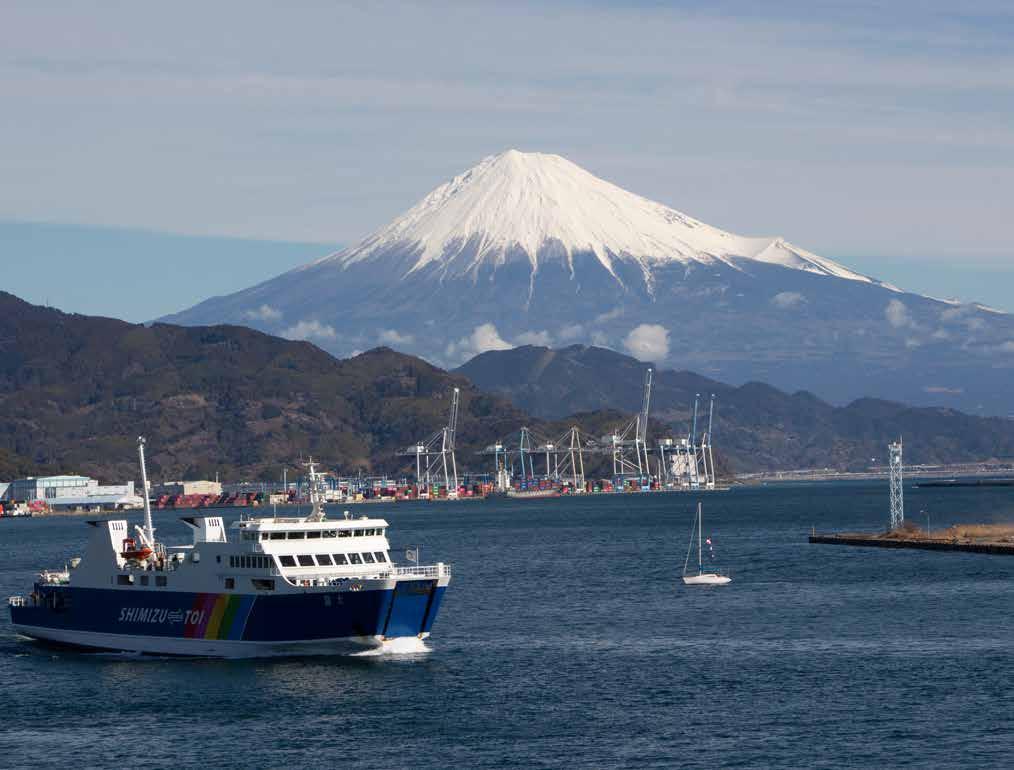
busy with life, with people selling all sorts including fake branded products, masses of clothes, coloured lights.
Within minutes of getting off the shuttle in the centre of Fukuoka, we are attracted to a building with huge steps covered in trees. We climb, zig-zagging past massive planter boxes, up the side of a multi-storied building. A curved glass atrium rises high above the roof – which we eventually get to – finding there a small garden and an observatory.
Next, we find a park next to a tidal river with cycle lanes, shading trees, cafés. We cross a couple of bridges and keep going until we come to Hakata Station – where it is time to get our courage on. Having missed out on a shore excursion to experience the famous bullet train, we’ve decided to do it anyway. A staff member at the info centre inside the station is, as always in Japan, super helpful. She explains the system, points out where to go; the ticketing machines have English options and soon we are onboard and on the way to nearby Kakura. It isn’t a long trip –maybe 20 minutes – but it is thrilling.
At Kakura we walk to a castle then back to the station for the return trip, this time on a bullet train painted pink with Hello Kitty décor.
Next on the ship’s itinerary is Himeji, famous for its beautiful white castle, reminiscent of herons in flights with elegantly sweeping rooflines. Inside is rich in wood, floorboards smooth from years of hurried walks along the long gallery, generations of people stepping into
the small rooms opening off it, all with views of the castle gates. These rooms would have been used for defense – stone throwing, arrow shooting – if the castle had ever come under siege, which it didn’t.
From the main part of the castle, we climb up and up steep, very narrow stairs. The town spreads out below and behind the castle walls are intriguing gardens. Here, we find ancient bonsai, bamboo and pine tree gardens, and another featuring a lake dotted with bright orange carp, leafy reflections, a waterfall, bridges and stone paths around mossy pockets.
On the way back toward the town centre we venture into a tiny dumpling kitchen, ducking under the bunting at the door. Two smiley young men work around each other, pinching casing around portions of filling, popping dumplings into hot water, shifting them onto a hot plate for a quick fry before serving them. Eight each for around $5NZD. Delicious. Back on board, a Taiko drumming group entertains from the pier; a couple of characters, one dressed as a duckling, the other as an egg, bob along to the rhythm.
To get to Himeji, we had spent another day at sea, sailing through the Kammon Straits between islands of Kyushu and Honshu under a huge bridge, into the Inland Sea before heading back out to the Pacific Ocean.
Having attended another lecture about Japanese culture and history, and noted the highlights of the port talk, we are amped for Osaka. A big, vibrant and busy city, we negotiate local trains to get to a giant, crowded inner-city mall where

the energy is high. World-famous brands are on street level; we find shops more interesting to us on levels above. Then we make our way back to port to queue for a massive ferris wheel set right next to where Westerdam is moored. The slow ride carries us high above the city and gives us a bird’s-eye view of our ship.
Sailing between Osaka and Shimizu is a bit rough. While the rolling motion doesn’t disturb our sleep too much, the change in weather puts a serious question mark over whether we will see Mt Fuji.
At dawn, I push hard against our veranda door, fighting a strong wind. It is very cold and overcast, but not heavily so. Leaning forward for a better view of the land we are passing, there it is! In absolute glory, the sun just tingeing its flank, the famous mountain. As the sun rises, the light changes, its angles and shades shifting with time. Thrilled, we join other passengers on various decks, all clicking, clicking, clicking photos.
Later that morning, the Westerdam ties up in the port of Shimizu, popular with tourists for its views of Mt Fuji. Interested in the associated art created in honour of the mountain, we decide to visit the museum of Utagawa Himeshige, an artist from the Edo period, famous for woodcut prints of the region. Images of waves, rain, tiny figures dressed in kimono and wooden sandals, the famous pointy mountain – these are what we want to see.
By now familiar with Japanese rail, we take a local train to the tiny town of Yui, flag down a taxi, and find the museum.
Although easy on paper, if a kind train driver hadn’t checked the destination details on our tickets, we may not have made it. But we do. It feels quite an accomplishment and the museum itself is wonderful, with displays explaining the print process, featuring tools and modern renditions, as well as lots of original artworks.
As we leave the museum we realise the turtle-like rocks in a channel outside the gate are actually turtles.
It is our last night on board. To celebrate, to commiserate, to mark the end of the journey, we splash out on the Taste of Tamarind, another specialty restaurant, for another memorable culinary experience.
In Tokyo, we have to leave our cabin. We must join the throng of departing passengers, follow instructions to the coach where our luggage is waiting, submit to being ejected into a new place without someone to explain. Of course, we manage – and enjoy – the following days in that vibrant, stimulating, overwhelming city – but we’d been so spoiled on board Westerdam, it is a bit of a shock.






Imagine: the most clichéd confection of a tropical beach. Ocean so clear it looks like it should taste sweet. Icing sugar sand. A lagoon the colour of blue Powerade. Then multiply that by brilliant sunshine and a complete absence of crowds. Paradise is an overused descriptor, but in this instance it’s entirely applicable.
This is the Motu Vaiamanu – aka the motu piscine or island swimming pool – on Raivavae in the Austral Islands, tucked away in the southern corner of French Polynesia. It’s almost too good.
But the journey to paradise was not entirely smooth sailing.
It’s 3.48am, 15 hours into the voyage between Tahiti and the Australs on board hybrid cruise/cargo ship the Aranui 5, and the TV remote, teaspoons and coffee pods are skidding around my cabin with the tumultuous rolling of the ocean. I crawl out of bed, bleary-eyed, to stow the flotsam and jetsam.
We’re still mid-ocean come daybreak, riding the undulating cerulean swells. I emerge tentatively from my cabin, staggering along corridors like a drunk to see how the other 180 mostly septuagenarian passengers have fared.
In an upper deck lounge, I find a ukelele lesson. Inside, people sit and strum, creating off-key chords and laughter. Picture windows frame an ocean painted a shade of blue I don’t recognise. Is it royal? Peacock? Lapis?
Our first stop in the Austral archipelago is Rimatara Island where we land in a haze of sea spray and smoke. The fires are part of a welcome ceremony, a rite that was traditionally used to protect the island from invaders.
A tent decorated in fronds and foliage provides shade, a salty breeze takes the edge off the tropical heat.
The Austral Islands are a small constellation of volcanic nuggets poking out of the Polynesian ocean, 600km south of Tahiti. Over 11 days, our Aranui itinerary includes visits to five of the inhabited islands: Rimatara, Rurutu, Raivavae, Rapa and Tubuai.
Universally tidy and picturesque, the tiny communities on each island are bound by isolation and are so far unimpacted by the ravages of tourism. In the Australs there are no polystyrene resorts with swim-up bars, no golf courses, no drone of jet skis or clatter of scenic helicopter flights. As we’re disgorged from the ship’s tenders, reminiscent of WWII landing craft, we’re draped in fragrant lei and as we take photos, the locals do too – the curiosity
of laughter through the crowd as they’re translated from his native French to English. We watch with bated breath as a young man steps out from the musicians to lift a large boulder. This ceremony is based on an island tradition: if he fails to lift the rock we will not be allowed to visit the island, as it’s a bad omen. Cheers erupt from the audience as he hoists the boulder onto his broad shoulder and waves to the crowd, grinning.
It’s a good job that we’re granted permission – there’s a lot to discover on Rurutu. We explore caves carved out of ancient coral and limestone, watch as plump red berries miraculously transform into pale coffee beans at the island’s roastery, and feast in the garden of the mayor’s house under a red and white circus-sized marquee. The island’s generosity is evident once again as we take plates piled with authentic
Universally tidy and picturesque, the tiny communities on each island are bound by isolation and are so far unimpacted by the ravages of tourism.
works both ways, untainted by cynicism.
Island tours involve piling onto rickety school buses, or into locals’ own cars decorated in bright fabrics, fresh flowers and woven leaves.
On Rurutu – a lagoonless 33km2 island shaped like a miniature Africa – we arrive on another windy wharf, greeted by locals with baskets of freshly picked tiare to tuck behind our ears: the left if you’re married, right if you’re single. Conches sound, drums pound, decorative foliage abounds.
Shepherded to the community centre we are welcomed with a speech from the mayor whose jokes cause delayed ripples

Polynesian food – poisson cru, raw fish doused in coconut milk, crisp barbecued pork, and a strange but delicious gelatinous pumpkin-based dessert.
Our island tour is accompanied by a colourful convoy of dignitaries and police, dancers and musicians in vehicles with wing mirrors draped in festive greenery. The whole day is soundtracked by a mobile party mix as the band picks up their driving Pacific rhythm at each stop.
The cave of Ana A’eo, the largest on Rurutu, is a yawning mouth filled with ferns that is used for occasions like this, to welcome visitors. Musicians peel off

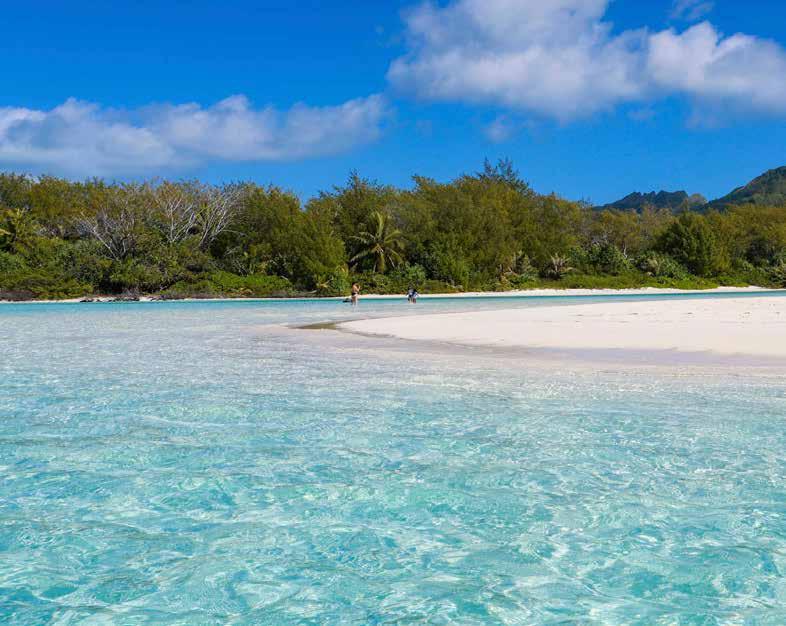
from the convoy and as we pick our way through the rocks, we’re greeted by drums and conches, while teenagers clad in leaves flick their hips to the infectious rhythm, perched on top of flattened stalagmites.
On the daily transfers between ship and shore, I soon learn that it’s best to think of myself as cargo. Stepping from the bucking ship to the lurching barge is like trying to jump into a moving elevator. Rather than overanalyse it, I trust in the strong and capable seamen who manhandle me across the thrashing gap.
Unlike Rurutu, little Raivavae, just 16km2, is bordered by a magnificent turquoise lagoon. Here, we’re welcomed with floral garlands and freshly macheted coconuts to drink. In a makeshift pavilion


we eat a lunch of delicacies: Poisson cru (of course), tiny, briny balls of seaweed that burst like caviar between my teeth, giant clam curry, banana crêpes. Followed by more swaying, smiling dance, more drumming.
On this day, rather than join the bus tour, I set out to explore. Hiring a canarycoloured bike I cycle along smooth concrete roads, past banana palms, roaming dogs and waving locals to arrive at a sublime beach. White sand is fringed by ironwood trees and the water lapping at my feet could be distilled vodka. The distinctive shape of the Aranui – like a vintage clothes iron with its cargo crane handle – is framed on the horizon. There’s something special about discovering a spot so idyllic on my


own. However, my smugness evaporates the next morning when we are dropped ashore in the tenders at the very same beach. Maybe not such a secret after all. Ferried from one exquisite beach to the other side of the island in a friendly local’s ute, then, via a flotilla of small boats, we land at the collection of tiny islets that frame Raivavae’s motu piscine. I step ashore, aghast. It is like being in a simulation, implausible that a place like this should just exist in nature. Flowing between snow-like drifts of white sand, the sapphire water is warm and clear with a current that acts like a lazy river, drifting slowly from the one end of the islet to the other. In the shade, tables are laden with bottled water and fresh fruit. I sit on the shore, waves lapping at my sandy toes and eat sweet Javanese pomelo, its juice trickling down my wrists.
Life onboard the Aranui soon finds a comfortable rhythm. Not just the sway of the ocean, which I grow so accustomed to I take it with me to shore each day, but the daily habits that form. Most mornings I eat a breakfast of tropical fruit and crusty baguettes with a quartet of women from Adelaide. Three course dinners are enjoyed with people from Rhode Island, Paris and Tasmania – a random seating selection at first, but by the end of the

trip our group is referring to each other as family. Connections form fast.
“Māuru’uru!” “Merci!” “Ia Orana.” “Bonjour,” are phrases that become second nature. Regular announcements over the ship’s intercom are repeated in different languages. English is in third place for casual greetings.
While each of the Austral Islands has its own unique character, culture and dialect, Rapa stands apart. The southernmost of the Australs, it is a fishhook-shaped island with fewer than 500 inhabitants. Geographically, there’s nothing between here and Antarctica.
My first sighting is of dark, sharp spires like shattered crockery looming out of the mist. The Aranui eases slowly into a sheltered harbour formed from Rapa’s collapsed volcanic crater where the steep green hills and still water remind me of the Marlborough Sounds. It feels like coming home.
It’s not just Rapa’s landscapes that feel familiar. The welcoming ceremony, performed by the island’s teenagers recently returned from a school term in Tahiti, is unlike the other islands. Rather
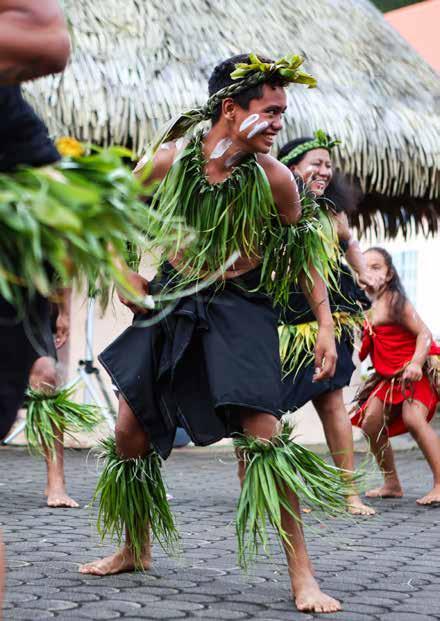

A full day at sea includes ubiquitous sunbathing on the rear decks. Other passengers participate in dance and cooking workshops or attend lectures on Austral Islands history.
than a sensual Polynesian sway, this is feisty – a kapa haka-like challenge that includes the flashing whites of eyes and pukana. In the dignitaries’ speeches, I pick out words ‘tipuna,’ ‘whakarongo,’ and ‘paki paki’ in the local reo Oparo that is so like te reo Māori.
Being further south than the Tropic of Capricorn, the climate on Rapa is subtropical with distinct seasons. There are no coconuts growing here, instead an abundance of stone fruit, apples and berries thrive, along with more ruby red guavas than I’ve ever seen in my life. We stroll around Ahurei village, picking fruit as we go, accompanied by a couple of curious kittens, a mob of kids on bikes, and teenagers who offer their services as bodyguards, jokingly, in broken English.
A full day at sea includes ubiquitous sunbathing on the rear decks. Other passengers participate in dance and

cooking workshops, or attend lectures on Austral Islands history. Some of the restaurant crew, freed from their duties between meals, play ping pong – I giggle at their infectious Polynesian laughter and howls of mock despair after each volley. A French couple sit quietly, practicing their newly acquired ukulele skills. New friends start exchanging contact details and air dropping photos. We’re coming to the end of the voyage and an air of sweet melancholy hangs over the day. As the sun sets a notice is broadcast through the ship: “Attention mesdames et messieurs…” the crew invites us to gather and throw our lei accumulated throughout the voyage into the ocean in farewell. I watch with misty eyes as our wreaths and garlands disappear in the Aranui’s wake, a trail of petals and memories drifting off towards the horizon.

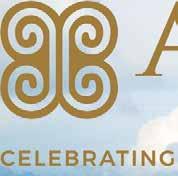



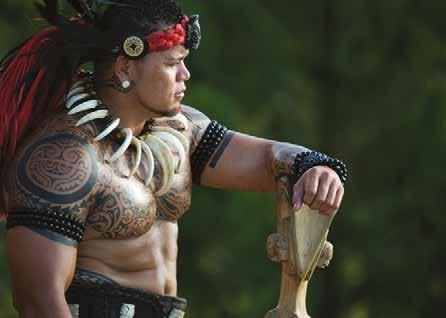


Immerse in the world’s most isolated islands on a cargo cruise aboard Aranui 5 to the Marquesas or new cruise destination, the Austral Islands
Authentic French Polynesia with a Polynesian crew
Small ship cruising (max 250 guests) on a working ship
Meals, activities and excursions included in the fare

IT WAS WHALING that first lured visitors to The Catlins. Today they come for the big open skies, rugged weather and beaches where the only footsteps on the sand are their own. It’s why Marie and Everd Strauss built their holiday home –or crib – at Jack’s Bay, an isolated arc of golden sand about six kilometres from Ōwaka, 120km south of Dunedin.
While others may have been put off by the isolation, that was the appeal for Marie, an artist, and Everd, an anaesthetist at Dunedin’s Mercy Hospital. They wanted an escape from busy careers and running a cattle stud farm on the fringes of Dunedin.
“We wanted a crib where there were no cafés or shops, where we would see noone,” Marie says. “The aim was a haven where we could read, listen to music, stare at the sea and do nothing.”
It was a long time coming: the couple, originally from South Africa, spent 26 years looking for the right spot to build their weekend getaway.
“We had a crib at Dunedin’s Long Beach for a few years but never used it because it was too busy. We really wanted something far removed from the busyness of life.”
In 2017, Everd spotted the 2,023²m section for sale in the newspaper; phoned his wife, telling her there were
penguins and sea lions on the beach. It came on the market on a Friday, and by Monday it was theirs.
Somewhat unusually for its coastal setting, the couple’s vision was for a simple concrete box.
“We’ve always liked minimalist architecture and wanted something totally industrial. We needed a building that could withstand the extreme weather conditions and was low-maintenance because we didn’t want our weekends swallowed up by gardening and painting.”
They called upon architect Rich Naish of RTA Studio to realise their vision, attracted by his love of brutalist

design. Also, Rich was born in Bluff so he understood the harsh environment.
The couple’s desire for their 145²m, two-bedroom concrete box to reference a lighthouse stayed truer to its coastal location.
“The project became known as The Lighthouse,” Rich says. “The round porthole window focuses your view on the horizon, the diamond patterned glass references the lamp house enclosure, and splashes of red, steel stairs and ramps are all reminiscent of the coastal lighthouses of The Catlins.”
Sustainability and climate resilience were also critical, he adds. “The house has a minimum floor level set for future sea level rise, but we installed an enclosed sub-floor so that the local nesting sea lions can’t access it.”
Insulated concrete panels are plastered to provide a warm and low-energy shell, while the outdoor room has two weather lines of glass doors; in summer the outer layer opens to the warmth and in winter it becomes a cosy conservatory with a woodburning fire.
While the crib is anchored in its marine location, Marie was keen for the interior to include nods to the couple’s heritage and travels.
“I wanted the black staircase to look like the ones I’d seen in the Paris Metro,” she says, while the fabric draped over the mezzanine is from Kenya, the spoils from Marie’s teaching days in Johannesburg.
We wanted a crib where there were no cafés or shops, where we would see no-one. The aim was a haven where we could read, listen to music, stare at the sea and do nothing.
“Traders would bring their collections to show the university curators, and lecturers sometimes had the chance to buy items.”
Marie is an inveterate collector whose rule is that only items with a good story make it across the threshold.
“Most of the items in the crib have been collected over a long time and each has a story to it. Even newer items, such as the dining chairs, have a story. We couldn’t find what we liked in New Zealand so every time we visited our son in Melbourne, we’d buy chairs to bring home, two at a time.”
You’d expect the home of an artist who specialises in ceramics and painting to feature numerous original pieces. And there are, both by Marie and other local and international artists.
“When we first talked to Rich about the house, he laughed when we said we were minimalists with a big art collection! But this crib is an extension of our home on the farm which includes our art collection. Even though it doesn't look like our farmhouse, it feels like another room of it.”
Most people who have built a house will tell you the process isn’t easy. That wasn't the experience of Marie and Everd. “It was wonderful to work with Rich and we had no challenges at all. Some people say they would never build again, but I’d do it in a heartbeat.”
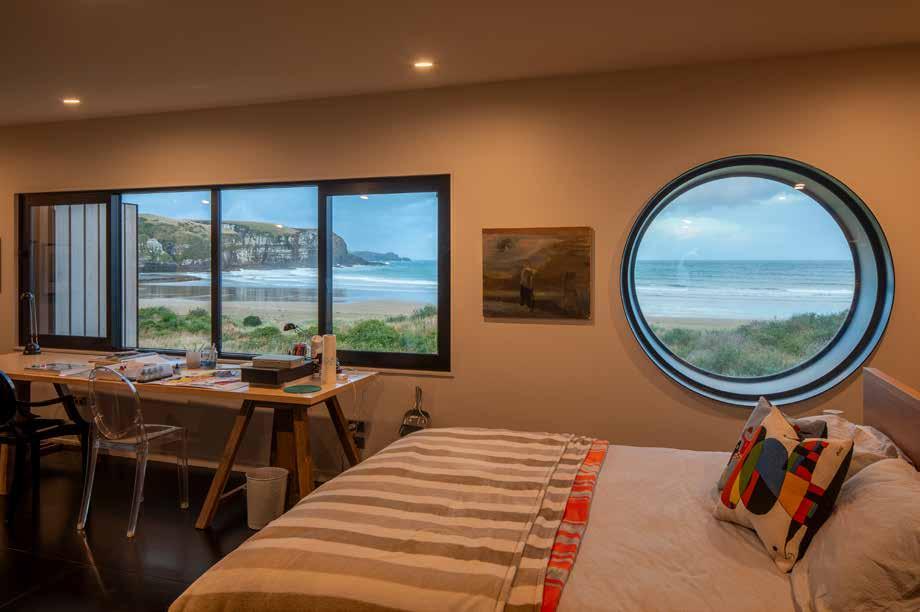
Sort jobs around the house with AA Home Book a Job. Do you have a dripping tap, new purchases to be assembled, an aircon or heat pump unit that needs servicing or a hole in your fence? To find out if AA Home Book a Job is available in your area and to book an AA-trusted trade professional, go online to aahome.co.nz

Perlina Lau has carved herself a unique position in media as the host of Radio New Zealand National’s arts show Culture 101, and star and producer of TVNZ+’s Creamerie.
What attracted you to working in media and entertainment?
I grew up doing a lot of performing arts: dancing, speech, drama and music. I had a work experience type thing at TVNZ
before I started uni, and I got hooked on working in the newsroom. I’ve always loved it. There’s a certain adrenaline involved with it, being in-the-know. And every day is different.
How have you found juggling being a broadcaster and a TV star?
I feel like there’s two sides of me and they satisfy the different parts. We’re a weekly show at RNZ and it’s more immediate, more fast-paced. It requires different skills, and it’s quite a different job. When I shoot Creamerie, it’s at a completely different pace. It’s longer days, but in some ways there’s more consideration because it's a slow process. And of course, I get to flex my acting muscles.
Is it important to be good with money when working in media?
I think the reason why I’ve always had one stable job is because I do worry about money. I like to have a steady role going, and then I can feel better about doing side hustles.
In general, does money matter to you?
I don’t think I’m a particularly materialistic person; for me it means being able to choose what you want to do, and go travelling and that sort of thing.
Are you a spender or a saver?
I’m actually both! If I want to spend on things, I find a way to make extra money to pay for it. I feel guilty about dipping into savings so I’ll go and find an extra gig to cover it. I’ll very rarely think I can't afford something, I’ll think, how can I afford it? I find a way!
Were you taught about money growing up? I had parents who worked really hard, seven days a week, every day of the year. I was role-modelled that work ethic from a very young age. They were pretty open about money. I was always very aware of what school fees were, what extracurricular activities cost. There was an awareness that things don’t just happen – it requires hard work, it requires saving, and it requires budgeting. That was made very clear to us.
Do you use a budget? What do you spend your money on?
I don’t have a physical budget written down, but I have a rough one in my head. And most of my spending money, to be honest, goes towards food. I love going out to dinners with friends – I know that if I have to rein in any spending, it’ll be on food. It’s too tempting being in Auckland!
AA Home’s tips for post-winter projects.
DREAMING OF LAZY SUMMER days relaxing al fresco? Now is the time to whip your outdoor spaces into shape with a spring clean.
Every good project starts with a plan. Before you let loose with the water blaster, paintbrush or pruning shears, take stock of what needs to be done. List the jobs in order of priority and decide what you want to tackle yourself and what’s best left to the experts.
Don’t let dirty weatherboards and a mouldy patio suck the spring out of your step. Give your property a facelift by washing down the exterior walls, cleaning your roof, and waterblasting the driveway, pathways and decks. Most houses benefit from an annual wash; it helps prevent rot, stain and mould growth, and is an excellent way to send creepy crawlies packing. According to the experts, soft washing is the way to go. Not only does it help prolong the life of your paint and exterior building materials but it’s much gentler than commercial washes. Meanwhile, when it comes to pathways and decks, the buildup of moss and mould over winter can create a slip hazard, so waterblasting these areas protects both your property and your self. If this sounds too daunting to tackle yourself, call your local handyperson or get in touch with AA Home. They offer the full gamut of handyman services, from waterblasting and house washing to staining decks and fences.
Gutters play a starring role in keeping your home healthy. They redirect rainwater away from your roof, walls and foundations and protect your home from water damage. Turning a blind eye to clogged, overflowing or sagging gutters can lead to big problems, so show your gutters some love. It pays to inspect them regularly, clear them of leaves and debris, and address any issues quick smart.

But have a “hmmm” before you jump on that ladder. Climbing ladders and working at heights can be a recipe for disaster if you’re inexperienced or don’t have the proper safety gear. Gutter cleaning may be a task best left to the professionals and is one of the many home maintenance services offered by AA Home.
If you’ve been too busy watching Netflix to keep on top of your garden over the winter, a good tidy up is your best first step. Rake up leaves and twigs and get stuck into the pruning and weeding. Apply a 10-15cm layer of mulch to reduce weeds, improve soil health and retain moisture during the hotter months. It’ll also make your garden look polished. Boost spring growth by giving everything a feed and treat your garden for insects and other pests that traditionally appear when plants start to bud or flower. Nothing screams ‘sunny days ahead’ like a good lawn, so start getting yours in tiptop shape. Feed lawns, dig out or spray competing weeds, and fill any patches with handfuls of grass seed mixed with topsoil. Be sure to save some energy for the fun stuff, like planting summer bulbs, filling your pots and containers with annuals, and hanging up the bird feeder.
Outdoor furniture, and a tidy garden shed, can make or break your outdoor space. Repair any furniture that’s broken, give it a good scrub, and re-stain, oil or paint for the ultimate refresh. While you’ve got the paintbrush out, use it on tired fences, sheds and pergolas.

If it’s time to upgrade your outdoor furniture, there are a growing number of excellent flatpack options around. Need help putting it together? AA Home has a flatpack assembly service which covers everything from garden sheds, louvre systems and barbecues to outdoor furniture and trampolines. Cap it off with some new outdoor cushions and a sun umbrella, and voila! Ready for summer.
Nothing beats the great outdoors, but when the summer really starts to sizzle, air conditioning can be a godsend. If you don’t already have a heat pump or air conditioning unit, spring is the perfect time to consider installing one. AA Home has partnered with HRV to offer home ventilation, water filtration, and heat pump installation to Kiwi homes.

Already got one? An estimated 90% of unit failures are due to units not being cleaned correctly, so ensure continuous comfort and peak performance with an annual service. Get it done right and book a job with an AA Home air conditioning specialist.
If you’re looking for help sorting jobs around your home, visit AA Home at aa.co.nz/homeservices AA Home Book a Job is our online service for booking AAtrusted trade professionals to help with jobs around your home, at a time that works for you. Easy and convenient online booking process.
Schedule for a time that works for you.
Receive an online estimate before the job.
Up to 10% discount if you’re an AA Member, AA Home Response subscriber, or AA Insurance Policy holder.* End-to-end service.^
*AA Members, AA Insurance Policy holders, and AA Home Response and AA Home Response Plus subscribers receive up to a 10% discount for the initial estimated callout price by entering their Membership, Subscription or Policy number.
^Payment is taken directly with the provider for flatpack assembly, all home inspections and HRV installation services.

After years mixing live music, spending time in recording studios and touring with bands, Dunedin’s Tex Houston has made a business of building unique hi-fi speakers by hand.
HE’S A SOUND PERSON, an excellent listener. Someone whose ears have been relied on by musicians on stage and in recording studios for decades. Now Tex Houston has used those skills to forge a business making high-end, hand-crafted hi-fi speakers.
“I was still doing recording projects and live sound but less touring over the years, and not wanting to be idle, I thought I’d build speakers for a bit of fun,” Tex says.
He tailors the speakers to his ears – “but they’re made acceptable to other ears as well! And I have always had good quality studio monitors as reference points.”
It’s his background at sound desks for live gigs and in recording studios that provides the edge, here. His ears are well-honed. Tex has been an audio engineer for more than 40 years, working with literally hundreds of New Zealand

That fun has turned into a range of creative designs described as “the most beautiful sound you’ll ever see,” with curvaceous, multi-layered birch-ply boxes housing precision-balanced sonic componentry imported from Europe. Tex Tone speakers come in four models – the Tex Tone Classics, Classic Minis, Towers and Consoles. Some are hand painted by artist friends: Chris Knox, Bob Scott, Nicola McLaren and David Kilgour. They’re at the higher end, dollar-wise, but “not outrageously so,” and the price reflects their quality, Tex explains. “I found that every time I upped the quality of the drivers, the quality of the speaker leapt up as well.”
musicians, many associated with the Flying Nun label including The Clean, The Chills, The 3Ds, Dimmer, The Bats and David Kilgour & The Heavy Eights. He is credited on numerous albums and has toured the world several times over with Kiwi bands. He is a bit of a legend in New Zealand music circles.
Having had a degree of success making a monitor from scratch, years ago, it was a natural progression to building home hi-fi speakers. He didn’t want a “boring old box,” so cut a shape from a piece of flatboard – multiplied and layered it –and realised he could make any shape he wanted using a jigsaw and router.
“It took several months to make that first prototype,” he recalls. “They sounded OK but there were a few things I didn’t like so I started the process again... and then I just kept going until one day, I thought – ‘they sound good and they look good!’ I had to spend more on the components until I got what I was happy with.”
Each time he changes the driver or the shape of the box, Tex must redesign the ‘brain’ that drives and balances the sound quality. That involves a recipe of capacitors, inductors and resistors, in varying quantities and values, with a dose of wizardry. His speakers are appreciated for a rich, sonic signature and impressive bass response.
They also look fantastic, as elegant and unique pieces of contemporary furniture. The most beautiful sound you will ever see, indeed!
Speakers are available at Dunedin’s Relics HiFi, as well as Turned On Audio in Auckland and textone.co.nz
AA Directions has a pair of Tex Tone Classic Minis , valued at $2,900, to give away. To be in to win, send your name and contact details to Tex Tone Speakers Giveaway, AA Directions, PO Box 5, Auckland ,1140, or enter via our website aadirections.co.nz by November 30, 2024.


NEW ZEALANDERS are doing it tough. Household living costs are up 5.4% in the year to the June 2024 quarter, with higher mortgage repayments (up 26.7%) and insurance costs (up 18%) leading the charge. Those fortunate enough to own a home will sacrifice pretty much anything to keep the roof over their heads, but in the face of rising costs, protecting our greatest assets is taking up a bigger portion of many household budgets.
According to the Insurance Council of New Zealand (ICNZ) – which represents the general insurance industry such as home, contents and vehicle – the current economic climate is filtering through to our insurance decisions.
“Many New Zealanders see the value of insurance to protect themselves and their property, with the uptake of residential insurance among the highest in the world at around 96%,” ICNZ Communications Manager Patrick O’Meara says. “However, we know it’s tough for Kiwis dealing with the cost of living and there are signs of a drop off in contents insurance.”
AA Insurance (AAI) Chief Product and Marketing Officer Shaun Rees has noticed a similar trend.
“Like most businesses, we’re seeing more customers considering their position and making different decisions that reflect the current environment,” Shaun says. “We’ve seen an uptick in people shopping around, and a trend around people considering making cuts to their cover.
“People tend to view home, car and life insurance as really important. Contents is the first to go or be cut back, along with pet insurance. We’ve also noticed people selling their second cars to reduce costs.”
But skimping on insurance is not something Shaun recommends, unless you absolutely have to. Even then, he says it’s best to only view the cuts as a temporary measure.
“Insurance can be a key building block of financial wellbeing. We put a lot of hard work into building what we’ve got; so thinking about how best to protect it if the unthinkable happens is really important. Insurance can be a crucial part of protecting the things that mean the most to you.”
So what’s driving those rising prices? Not surprisingly, Patrick says recent weather events have played a starring role.
“The Reserve Bank reported that premiums tend to trend upwards after
large-scale natural events such as last year’s Auckland Anniversary Weekend flooding and Cyclone Gabrielle, and we’re still seeing the effects of those.”
With climate change fuelling extreme weather, this looks set to be an ongoing issue, both for insurance providers and customers.
“One of the biggest challenges for our industry is how we can continue to keep insurance accessible. Insurers are looking at ways to help customers manage their cover to protect homes, contents and cars so that their cover meets their needs and budget,” Patrick says.
“The prospect of more frequent and severe weather events also requires clear leadership and a co-ordinated approach across central Government, councils, and many sectors to ensure risk is reduced and insurance is accessible in the future.”
That’s all very well, but for people finding it a challenge to pay their premiums right now, they may want to review how they structure their insurance.
Shaun says there are several options to consider. The first step? “Jump online or get on the phone to discuss your situation with your insurance company. People often think their insurance policy is an annual contract and you can’t change it until it’s renewal time, but that’s not the case. You can look at your insurance and make amendments to your policy any time.”
Both Patrick and Shaun suggest some other tips:
• Shop around, compare quotes from multiple providers.
• Consider whether adjusting your excess levels could suit your circumstances – usually, the higher the excess, the lower the premium.
• Have a look at any optional extras you pay for under your policies (for example rental car benefit and glass cover) and if these are right for your current insurance needs.
• Review your level of cover – could changing cover levels work for you?
For instance, you might decide to move from comprehensive motor cover to third party cover for your car.
Shaun says information is key. “It’s important to understand what changing your policy will mean for your level of protection, so it can be really helpful to talk through options first with your insurer.”
If the cost of insurance is hitting home, talking to your insurer to find out more about how you can structure your policies might be the way to best meet your needs.
SARAH CONNOR is a Wellington-based speaker and advocate who champions the need to raise awareness about menopause within communities and workplaces. In the lead up to World Menopause Day on October 18, she shares why this is an important topic – and not just for women.
What is menopause?
In basic terms, menopause is a series of hormonal changes which are not that different from puberty, though the reverse of puberty.
When people talk about menopause, they’re generally talking about the years leading up to it, known as perimenopause. This is when the hormones oestrogen, progesterone and testosterone start fluctuating and causing noticeable changes, which can kick in any time from the late 30s through to late 40s. It’s a period that could last from two to ten years.
What are some of the symptoms of perimenopause?
There are about 30-40 symptoms that people can experience. It can be hot flushes, night sweats, mood changes, anxiety, depression, irritability, memory loss; it can be suddenly feeling enraged for what seems like no reason. About 70% of women experience significant symptoms which impact their quality of life.
How did you start your journey to being a menopause campaigner?
Five years ago, I was 46, fit, happy and healthy when I started to experience changes that were out of character for me. One day I was driving home, and I suddenly felt like my head was on fire. It gave me a real fright. Over the next few months all these other changes started to kick in. I couldn’t sleep at night; I was
Jo
really anxious for no reason. I felt tearful and flat. For someone who had always been cheerful and energetic, it was so confusing and worrying.
Eventually I discovered the Wellington Menopause Clinic. They assured me that everything was entirely normal, that this is what perimenopause looks like and that there were lots of things that I could do to help manage it.
I realised that there was a whole generation of women who had a similar lack of understanding.
I hosted a dinner called Menopause over Martinis to bring together my friends of a similar age, and those older, wise women who’d helped me. Then
in 2020 I created a website which had information, conversation starters and all the resources that I wished I’d had when I was going through it. My mission was to make it all available in one place. From that, I started doing lunch and learn sessions and began having these discussions more broadly. It all just evolved from there
Why is it important to raise awareness about menopause?
I’ve had a lot of men tell me that they want to be informed and supportive, but they don’t really know how, especially in workplaces. I’ve been really open to including men and young people in the conversation – it shouldn’t just be reserved for people who are in the middle of it.
What do you most want people to know about menopause?
It’s a normal stage of life. You’re not losing your mind. You’re not the only one. We’re meant to go through these stages and menopause is one of them. Hormones have the power to change our minds and our bodies. It’s ok to talk about it and it’s ok to ask for help. And help is available.
Healthify.co.nz
Menopauseovermartinis.org
The full interview with Sarah Connor is online at aadirections.co.nz



Jenni Ryan joined the AA as Chief Marketing Officer early last year.
What attracted you to the role?
It’s a marketer’s dream to be the guardian of a brand that is trusted and loved in the way Kiwis love the AA. The responsibility to champion 1.1 million Members’ needs, as well as the customers who interact with our products and services, is one that I take seriously.
Has it turned out to be what you expected? Everything and more, in the very best of ways. Learning and understanding everything the AA is involved in, over and above our iconic AA Roadservice and Member Benefits programme, has been a real eye-opener. From advocating for road safety, to our support for SADD and school road patrols, to our extensive range of AA products and services – we have a real connection to communities right across New Zealand and I couldn’t be prouder to say I’m with the AA!
What does your role entail?
I lead the Marketing and Membership team and beyond championing our brand, we hold two key responsibilities. The first is ensuring AA Membership is highly valued by our Members and secondly, providing marketing expertise for AA products and services. With everything from Roadservice to pet insurance to driving lessons, there is always something exciting to offer our Members and customers.
Will Members see change from the AA in the coming months?
We have some exciting times ahead. We’re focusing on digital channels that
will enable our Members and customers to engage with us in new ways. Further to that, we’re looking to build on the value we already provide our Members, with new benefits from within the AA and our partners. Watch this space…
Are there challenges ahead, do you think?
The AA has been around for more than 120 years, and during that time we’ve evolved to meet the changing needs of Members and customers. We’re continuing to evolve as an Association and I’m confident that we are leaning into the right areas to ensure we have a bright future.
And reasons to celebrate?
Our Members are our reason to celebrate; more than 1.1 million now trust the AA to have their backs. With our Roadservice heroes undertaking 490,000 callouts a year and 4.8 million in the last 10 years, you can’t argue with that kind of experience! I’m also really proud that our AA Member Benefits programme now has over 40 ways for our Members to save. In the past year they've saved at least $33 million – including $17 million on AA Insurance policies alone.
What do you enjoy or value most about working at the AA?
Our people, our values and a strong culture make the AA a very special place to work. At the heart of it, the AA is a club and most of our employees are Members, so each and every day we’re working to create value for other Members just like us.
How does your team contribute to the overall goals of the AA?
Our purpose is to care for our Members and the people, places and spaces that are important to them. Our intent is for the AA to be the most loved, trusted and connected brand, and my team is laserfocused on ensuring our Members get the most of everything we have on offer.
What’s one piece of advice you wish you had received earlier in your career? It’s a cliché but the saying, ‘do something you love and you’ll never work a day in your life’, is so true. I’ve been lucky to have some wonderful roles throughout my career, AA included! I think the other key piece of advice is to always remember to look for the learning, to look for the
Supporting assistance dogs is an honour for AA Pet Insurance.
AA PET INSURANCE is now in its third year of partnership with the New Zealand Epilepsy Assist Dog Trust (NZEADT).
For every AA Pet Insurance policy purchased, a donation is made to support insurance premiums for service dogs and assist the NZEADT in their mission to help people living with severe epilepsy achieve independence.
NZEADT Board Member Jan McEwen highlights the significance of this ongoing partnership. “We are delighted to be partnering with AA Pet Insurance. Vet expenses can be an unexpected cost at any stage of life for a service dog so knowing that our insured dogs are covered will be very reassuring for our financial planning.”
AA Chief Marketing Officer, Jenni Ryan says that it is fantastic to see the partnership between the NZEADT and AA Pet Insurance strengthen and grow. “We’re proud to provide insurance protection for these life-changing service dogs, offering peace of mind to their owners. Each new policy we sell supports the NZEADT, giving more people the freedom and independence they deserve.”
Founded in 2007 by Andrea Hawkless, the NZEADT enhances the independence and security of people with epilepsy with highly-trained assistance dogs, inspired by Hawkless’ personal experience with her son’s condition.
opportunity because even in adversity there is a silver lining to be gleaned.
Are there any hobbies or interests you pursue outside of work?
I do have a bit of a passion for projects. If it isn’t a house improvement plan, then it’s researching a travel dream! I’m also a board member for NZ Sculpture OnShore which supports Women’s Refuge New Zealand and, with two active kids, life can get very busy outside of work, but I wouldn’t have it any other way.
What is your favourite holiday spot in New Zealand? Where do you plan to spend your Christmas break?
You can’t beat a New Zealand summer in my mind! There are so many magical spots – beaches a-plenty, slow-paced towns, quaint cafés with relaxed vibes and good people. As a family, we’ve made a point of seeing more of New Zealand over the past few years – everywhere from Russell, to Matakana, Martinborough, Nelson, Queenstown, Wānaka and Hawke’s Bay – so many great destinations! But we do have a fondness for Waiheke Island, so that might be on the cards for this year.

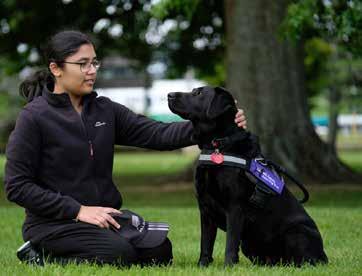
AA Shop has a range of portable solar-powered generators.
HARNESSING THE POWER of the sun and storing it for a time or place with no electricity: this is what the latest, clever products to arrive on AA Shop’s virtual shelves do. Bundling portable power stations and solar panels, the EcoFlow range is designed for emergency backup during power cuts or off-grid adventures, providing reliable and sustainable energy alternatives.
Various sizes are available, from combinations to replace diesel or petrol generators to smaller and lighter camping models. Top of the AA Shop’s range is the EcoFlow DELTA 2 bundle with a 220W bifacial solar panel and high-capacity 1024Wh battery with multiple output ports, including AC, USB, and DC. It can charge or power a wide range of devices and once drained, fully charges in just 4.7 hrs with full sun. It can manage up to 89 phone charges, 16 laptop charges, eight hours of TV or 31 hours of lighting.
The same solar panel can be combined with the EcoFlow RIVER 2 Pro Solar Generator, with 768Wh capacity, providing enough power for up to 6.1 hours of 120W refrigeration or 11 laptop charges. The EcoFlow app lets users control and monitor from their phone, to view charging levels, customise settings and adjust charging speeds.
While all are portable, the RIVER 2 MAX and RIVER 2 are lighter and smaller again, combining power stations and lightweight solar panels ideal for parking outside the tent in summer to keep mobile phones topped up and the plug-in chilly bins chill.
See shop.aa.co.nz for more details.










Auckland’s aquarium is a popular AA Member Benefit for families.
AA MEMBERS inspired by this issue’s cover and the interview with aquarist Jenna Van Ginkel on p.33 can visit SEA LIFE Kelly Tarlton’s for less, with a 30% discount on general admission tickets. The aquarium, on Auckland’s Tāmaki Drive, is a spectacular water wonderland and home to over 30 live animal exhibits including sharks, seahorses and penguins.
The 30% discount applies to a full priced ticket per AA Member, per visit; to get the discount use your AA Membership card online or at the aquarium.

See aa.co.nz/membership/benefits for more details.
THE LATEST WIN for AA Members: an exclusive discount to the NZ Opera. NZ Opera has been bringing worldclass performances to the stage for over two decades. Now, in a new arrangement with NZ Opera, AA Members can enjoy those performances at a great price.
To receive 15% off full priced Adult Gold, A Reserve and B reserve tickets to NZ Opera productions, Members can book online using the promo code AANZO2024*.
Of this new partnership, NZO General Director Brad Cohen says, “New Zealand Opera is delighted to join forces with the AA. Opera in Aotearoa is truly for everyone. We don't just present world-class performances, we also bring exceptional Kiwi artists home, showcase our local talent, and support the growth of emerging stars, both on and off the stage.
“If you haven’t attended the opera recently, I warmly encourage you to take advantage of this exciting new partnership and experience the dynamic and innovative productions we are creating at NZ Opera in 2025.”
Keep an eye out for news and updates on NZ Opera's 2025 season – with performances across Aotearoa, and exclusive discounts available seasonwide for AA Members.

*See aa.co.nz/nzopera for details.



AA Members shopping for cars can save on pre-purchase inspections.
BUYING A SECONDHAND CAR can be exciting but daunting, especially when unsure about its true condition. That’s where the AA Pre Purchase Vehicle Inspection steps in. Conducted by our experienced mechanics, this service involves a comprehensive 100+ point check that covers everything from the vehicle’s engine and brakes to its suspension and tyres.
The inspections are offered at selected AA Auto Centres around New Zealand. If you live in Auckland, Wellington, Christchurch or Whangarei, we offer a mobile service where the inspector can come to you, provided that the vehicle is on private property and on level ground so that it can be inspected safely.
This inspection usually takes around 90 minutes and offers peace of mind, helping identify potential repairs and ensuring the car meets safety standards. With the convenience of our mobile service, buying with confidence has never been easier.
Save $30 on the AA Pre Purchase Inspection as an AA Member ($199 AA Member / $229 Non Member). Contact us and see our website to book an inspection or learn more about how we can help you with your secondhand vehicle purchase.

See aa.co.nz/ppi for more details.




